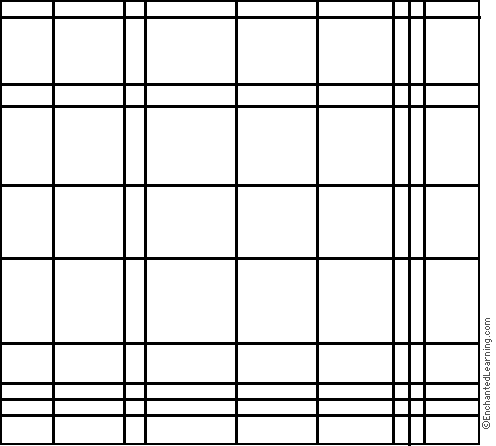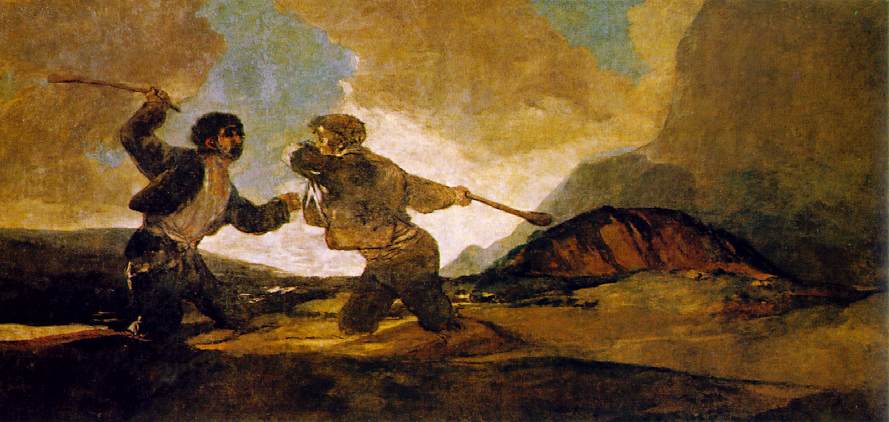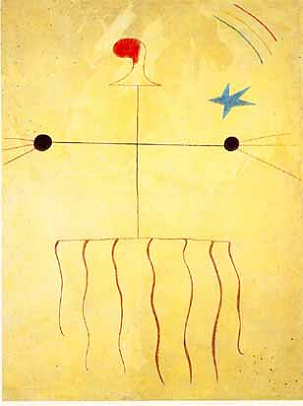|

|
Carey Hall Room 202
Office Hours: 2:15-3:30 p.m. (daily)
jspragins@gilman.edu
(410) 828-5212
4th Period Classes: Days 4, 5, 9, 10 “Out of the crooked timber of humanity no straight thing was ever made.” - Kant
|
|
European
Humanities
EH31
|
|
|
Spragins
|
|
|
Spring
2011
|
|
|
Spring Outline:
|
|

The French Revolution
David, Jacques-Louis
Death of Marat (1793)
Musees Royaux des Beaux-Arts de Belgique
|
The French
Revolution
|
|

English Romantic Poetry
Blake, William
The Ancient of Days 1794
British Museum, London
|
Romanticism
(Intellectual Backgrounds)
English Romantic Poetry (Table
of Contents)
|
|

Nineteenth Century Ideologies
The Industrial Revolution
Manchester Factory Kids (1836)
|
The
Industrial Revolution and
Nineteenth Century
Ideologies
|
|

Heart of Darkness
(1899) Josef Conrad
Africa in 1885 from Black's Atlas of the
World
|
The Modern Era:
|
|

The Origins of World War Two
Hitler Campaign Poster 1932
|
The Test of
Liberalism
|
|

The House of Bernarda Alba
Federico Garcia Lorca (1898-1936)
|
The
House of Bernarda Alba (1935)
by Federico Garcia Lorca
|
|

Survival in Auschwitz (1947)
by Primo Levi (1919-1987)
|
Survival
in Auschwitz (1947) by Primo Levi
Final
Exam 2011
|
|
|
|
|
|
Month
|
Day
|
Cycle
|
|
Assignment
|
|
|
|
1
|
24
|
6
|
Mon
|
Exam Make-up Day
|
|
1
|
25
|
7
|
Tues
|
|
|
|

David, The Tennis Court Oath (1789)

Francois Rude, La Marseillaise, Arc de Triomphe,
Paris, 1833-1836.

Napoleon at St. Bernard 1800
|
|
Writewell Report: Mid-Year Exam
Usage Pretest
Second Semester Preview: Artifacts
Essay Site
The
Enlightenment Dream:
- Man is not
born in a sinful, depraved state.
- The end of life is life itself: the good life on earth, not life
after death in heaven.
- Man is capable, guided solely by the light of reason and experience,
of perfecting life on earth.
- To accomplish this great goal, we must free our minds from the bonds
of ignorance and superstition and our bodies from the oppression of
corrupt social authorities.
The French Revolution:
Homework:
To prepare for the Final Exam, read
Isaiah Berlin:
|
|
|
|
|
|
|
1
|
26
|
8
|
Wed
|
|
|
|

Jean-Jacques Rousseau (1712-1778)
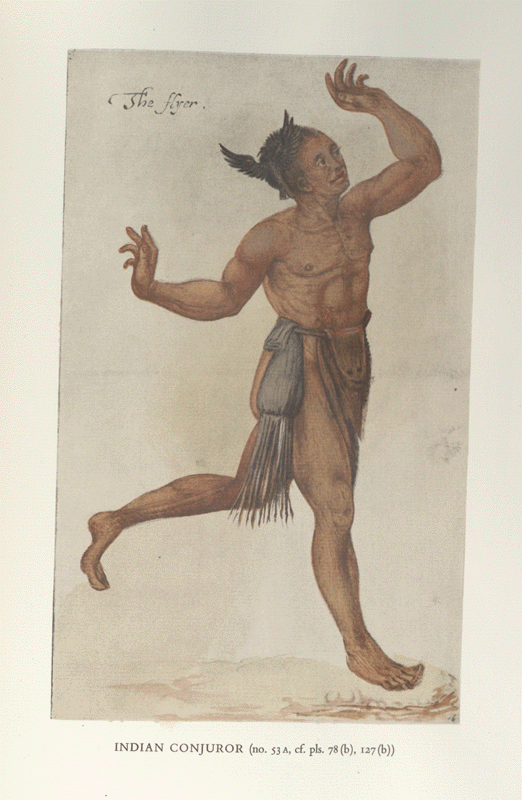
John White
Roanoake Watercolor (1586)

Delacroix, Eugene
Liberty Leading the People 1830
Musee du Louvre, Paris
|
|
Usage Pretest
Second Semester Preview: Artifacts
Essay Site
The
Enlightenment Dream:
- Man is not
born in a sinful, depraved state.
- The end of life is life itself: the good life on earth, not life
after death in heaven.
- Man is capable, guided solely by the light of reason and experience,
of perfecting life on earth.
- To accomplish this great goal, we must free our minds from the bonds
of ignorance and superstition and our bodies from the oppression of
corrupt social authorities.
Jean-Jacques Rousseau:
Homework: Reports
on the French Revolution
Outline
of the French Revolution (Powerpoint)
|
|
|
|
|
|
|
1
|
27
|
9
|
Thurs
|
|
|
|
|
|
The
Political Compass: Determine your own place on the political
spectrum.
The
French Revolution:
Jean-Jacques Rousseau:
Rousseau
vs. Voltaire: Equality vs. Freedom
Research
Reports
on the French Revolution
(Study Guide);
French
Revolution Map
The
French Revolution, Richard Hooker (2ndary)
Study
Guide Outline
of the French Revolution (Powerpoint)
Homework:
Reports on the
French Revolution
|
|
|
|
|
|
|
1
|
28
|
10
|
Fri
|
|
|
|

Jacques- Louis David, "The Death of Socrates", 1788

Jacques-Louis David,
Oath
of the Horatii, 1784. 11' x 14'.
Louvre, Paris

David, The Tennis Court Oath (1789)
|
|
France:
The
most advanced country in Europe
The
wealthiest country in Europe
The
intellectual center of the Enlightenment
The Liberal
Revolution (1789-1792)
Excerpts from Declaration
of the Rights of Man and Citizen (1789)
Liberal
Revolution Chronology
Outline of
the French Revolution (Powerpoint)
Reports
on the French Revolution
The
Crisis of the Monarchy (Hooker) Study Guide
The
Liberal Revolution (Hooker) Study Guide
- The
Estates General
- The
National Assembly
- The
Capture of the Bastille
- The
Great Fear
- Declaration
of the Rights of Man
- The
Civil Constitution of the Clergy
- The
Constitution of 1791
Homework:
|
Essay: Voltaire and Rousseau on the
French Revolution due at 3:30 p.m. on Thursday
|
|
|
|
|
|
|
|
1
|
31
|
1
|
Mon
|
|
|
|

Robespierre (6
May 1758–28 July 1794)

A
Sans-cullote Louis-Léopold
Boilly (1761-1845).

Execution of
Louis XVI
21 January 1793, from Decaux.

The Situation in France, Summer 1792
|
|
The Radical
Revolution (1792-1794)
French
Revolution Maps
Outline
of the French Revolution (Powerpoint)
Reports
on the French Revolution
Excerpts
from Robespierre’s
Speech of February 5,1794
Summary (Notes
from Palmer):
The
Radical Revolution (Hooker) Study Guide
- The
Declaration of Pillnitz
- Counter
Revolution
- The
Girondists
- The
Montagnard
- The
Sans-culottes
- The
Reign of Terror
- The Levee en
Masse
Homework:
|
Essay: Voltaire and Rousseau on the
French Revolution due at 3:30 p.m. on Thursday
|
|
|
|
|
|
|
|
2
|
1
|
2
|
Tues
|
|
|
|

Napoleon at St. Bernard 1800
(David Powerpoint)

David, Consecration of the
Emperor Napoleon I on 2 Dec 1804 (1806)

Turner, The Battle
of Trafalgar, as seen from the mizzen starboard
shrouds of the Victory (1806 to 1808)

Roubaud, Raevsky
Battery during the Battle of Borodino (1912)

Northen, Napoleon's
Retreat from Moscow
|
|
Napoleon
(1799-1814)
Outline
of the French Revolution (Powerpoint)
Reports
on the French Revolution
French
Revolution Maps
Summary (Notes from Palmer):
Napoleonics:
Napoleon
(Hooker) Study Guide
- The
Thermidorean Reaction
- Napoleon
Bonaparte
- The
Consulate (1799-1804)
- The
Napoleonic Code
- The
Empire
- The
Hundred Days
Ideologies of the French Revolution (review)
Homework:
Essay: Voltaire and Rousseau on the
French Revolution due Thursday at 3:30
For further reading:

Napoleon's
Conquests

Europe
in 1815
|
|
|
|
|
|
|
2
|
2
|
3
|
Wed
|
Parents
Conference Day
|
|
|
|
|
|
|
2
|
3
|
4
|
Thurs
|
|
|
|

Friedrich, Caspar David
Wanderer Above the Sea of Fog 1818
Beethoven, 9th Symphony, First Movement, Third
Movement
(Scherzo), Fourth
Movement "Ode to Joy" (1,
2,
3)
(1817-24)

Fussli, The Nightmare 1781
|
|
Essay:
Voltaire and Rousseau on the French Revolution due at 3:30
French
Revolution Quiz
Romanticism:
Painting from the
Enlightenment to Romanticism
Homework:
Hume, Kant and
Hegel: Intellectual
Backgrounds to Romanticism (Perry) (Study
Guide)
Backgrounds
to Romantic Poetry: Sophie
on Romanticism; Sophie on Kant; Sophie on Hegel
Sophie's World (Gaarder), pp. 322-341 Kant
Sophie's World (Gaarder), pp.
342-359 Romanticism
For further reading:
Kant:
A New Epistemology (Theory of Learning)
|
|
|
|
|
|
|
2
|
4
|
5
|
Fri
|
|
|
|

Blake, William
The Lamb from
Songs of Innocence and Experience (1789)

William
Blake, "The Tyger" from Songs of Innocence and Experience (1789)
|
|
Introduction
to Romanticism:
"What if you slept? And what if, in your sleep,
you dreamed? And what if, in your dream, you went to heaven and there
plucked a strange and beautiful flower? And what if, when you awoke,
you had the flower in your hand? Ah, what then?" -- Samuel Taylor
Coleridge
Backgrounds to Romantic Poetry: Sophie on Romanticism
Intellectual
Backgrounds to Romanticism Quiz
Review:
Multi-Media
Essay on Romantic Poetry (Due Tuesday 2/22)
William Blake (1757-1827):
Introduction
Homework:
Write a
paragraph about one of the following poems:
1. Read
the poem carefully. Look up any unfamiliar words in the dictionary.
2. What
is the poem's theme? What point is being made?
3. What
symbols does the poet use to make his point?
4. Read
your poem out loud. What musical devices does the poet use to help make
his point?
5. What
makes the poem Romantic?
Songs of Innocence and Experience (1789)
|
|
|
|
|
|
|
2
|
7
|
6
|
Mon.
|
|
|
|

Blake, William
The Great Red Dragon and the Woman Clothed in Sun c.
1806-1809
Beethoven,
Fifth Symphony 1st
Movement (1805-08)

William Blake, "London" from Songs of Innocence and Experience (1789)
|
|
Multi-Media
Essay on Romantic Poetry (Due Tuesday 2/22)
Backgrounds to Romantic Poetry: Sophie on Romanticism
William Blake
(1757-1827) Introduction
The
Blake Archive
(website)
Definition of Lyric
Poetry
Songs of Innocence and Experience (1789)
Homework: Blake Creative
Writing Exercise
For further
reading:
|
|
|
|
|
|
|
2
|
8
|
7
|
Tues
|
|
|
|

Blake, "The Sick Rose" from Songs of Innocence and Experience (1789)

Blake, "Garden of Love" from Songs of Innocence and Experience (1789)
|
|
Multi-Media
Essay on Romantic Poetry (Due Tuesday 2/22)
Kant's Categorical
Imperative (Nieman)
Old
English Popular Ballads: (Ballad
definition)
Sophie on Romanticism
Wordsworth and Coleridge, Lyrical
Ballads
(1798)
Romantic Paintings: Ballad
Prompts
Homework:
Creative
Writing: Ballad Assignment
For further
reading: Old Englidh Ballads:
|
|
|
|
|
|
|
2
|
9
|
8
|
Wed
|
|
|
|

Friedrich, Caspar David The Sea of Icec.
1823-25


Gustave Dore's Illustrations to the Rime of the
Ancient Mariner
(1870)

Turner, Slavers throwing
overboard the Dead and Dying - Typhon
coming on ("The Slave Ship") 1840
|
|
Lesson
Plan: Multi-Media Essay on Romantic Poetry
(Due
Tuesday 2/22)
Romantic
Paintings: Ballad Prompts
Samuel
Taylor Coleridge, "The Rime of the Ancient Mariner"
(1798) Study Guide
Gustave
Dore's Illustrations to the Rime of the
Ancient Mariner
(1870)
Homework:
Coleridge,
"Kubla Khan"
(1797)
For
further reading:
|
|
|
|
|
|
|
2
|
10
|
9
|
Thurs
|
|
|
|

Chris Ranes, Paintings inspired by The
Rhyme of the Ancient Mariner (1986-2000)

Delacroix, Eugene
The Death of Sardanapalous (1827)

Victoria Falls
on the Zambezi River between Zambia and Zimbabwe. The falls plunge more
than 400 feet.

Original text of Kubla Khan in Coleridge's hand (British Museum)
|
|
Multi-Media
Essay on Romantic Poetry (Due Tuesday 2/22)
Close Analysis: Coleridge: "Kubla
Khan" (1797)
Discussion:
- How do
both "The Rime of the Ancient Mariner" and "Kubla Khan" express Coleridge’s understanding of human nature?
- How does Coleridge use symbol in each poem?
- How
does the sound of each poem contribute to its meaning?
- What
makes these poems “Romantic”?
Close Analysis: Wordsworth's Ballads: "We are Seven"
(1798)
Landscapes
by John Constable
Homework:
|
Wordsworth from Lyrical
Ballads (1798):
For further reading: Wordsworth's Meditative
Poetry:
|
For further study:
|
|
|
|
|
|
|
2
|
11
|
10
|
Fri.
|
|
|
|

Greuze, The Village Proposal
(1761)

Constable, The Haywain (1821)

Constable,
The Cornfield (1826)
Vaughn
Williams, The Lark Ascending
(1914)

Constable, The White Horse (1819)
Photographs
of the Lake
District in England
|
|
Multi-Media
Essay on Romantic Poetry (Due Tuesday 2/22)
William Wordsworth:
Homework:
4th Period:
|
Early
Romanticism in Music
- Beethoven, 3rd
Symphony (1803) (Eroica)
1st
Movement (part one)
- Beethoven, 5th
Symphony (1808) 3rd
Movement
- Eroica
Keeping Score DVD and Website;
The
Eroica Website
- Beethoven, 5th
Symphony, 4th
Movement
- Beethoven,
6th Symphony (Pastoral) 1st
Movement (1805-08)
- Schiller, "An
Ode to Joy"(1785)
- Beethoven,
9th Symphony (1824), 4th Movement, Part One
- Beethoven,
9th Symphony, 4th Movement, Part
Two
- Beethoven,
9th Symphony, 4th Movement, Part
Three
- Beethoven,
9th Symphony, 4th Movement "Ode to Joy" Scene from
Immortal
Beloved
(1994)

The Gleaners Millet (1857)
|
|
|
|
|
|
|
|
2
|
14
|
1
|
Mon.
|
|
|
|

The Parthenon Marbles (447BC - 432BC)

The Parthenon Frieze (447BC - 432BC)
|
|
Multi-Media
Essay on Romantic Poetry (Due Tuesday 2/22)
The Life of John
Keats (Powerpoint):
Homework:
|
Keats Odes: Study
Guide
Analyze the poetic effects at work in one of
the stanzas of your poem.
|
|
|
|
|
|
|
|
2
|
15
|
2
|
Tues.
|
|
|
|

Severn, Keats Listens to a Nightingale (1845)

Dionysus and Maenad 486.BC
|
|
Multi-Media
Essay on Romantic Poetry (Due Tuesday 2/22)
Writing
Like Keats
Homework:
Keats Odes: Study Guide;
Keats
Lecture Notes
"To
Autumn" (1819)
"On
Melancholy" (1819)
"To
a Nightingale" (1819) (poetic effects)
"On a Grecian Urn" (1819)
An excellent Keats
webpage.
A Musical Analogue? Frederic
Chopin (1810-1849)
|
|
|
|
|
|
|
2
|
16
|
3
|
Wed.
|
|
|
|

Freiderich,,
Winter Landscape (1811)

Gericault, An Officer of the
Imperial Horse Guards Charging (1814)
|
|
Multi-Media
Essay on Romantic Poetry (Due Tuesday 2/22)
Keats Odes: Study Guide;
Keats
Lecture Notes
"To
Autumn" (1819)
"On
Melancholy" (1819)
"To
a Nightingale" (1819) (poetic effects)
"On a Grecian Urn" (1819)
An excellent Keats
webpage.
A Musical Analogue? Frederic
Chopin (1810-1849)
Homework:
|
|
|
|
|
|
|
2
|
17
|
4
|
Thurs.
|
|
|
|

Friedrich, Caspar David
Wanderer Above the Sea of Fog 1818
|
|
Lesson
Plan:
Homework:
|
|
2
|
18
|
0
|
Tues
|
Faculty Professional Day |
|
|
|
|
|
| 2 |
21 |
0 |
Mon. |
President's Day |
|
|
|
|
|
|
|
|
| 2 |
22 |
5 |
Tues. |
|
|
|
|

Delacroix, Eugene
Liberty Leading the People
(1830)

Delacroix, Eugene
Greece Expiring on the Ruins of Missolonghi
(1826)

Europe in 1815

Revolutions of 1848
Chopin,
"Revolutionary Étude", in C minor, op. 10, n° 12 (1830)
|
|
Romanticism
Essay Due at 3:30 p.m.
Romanticism:
Political
Backgrounds to the Industrial Revolution:
I. Review:
Ideologies
of the French Revolution
II. Europe
in 1815: Reassertion of Conservatism at The Congress
of Vienna
III. But
was the genie out of the bottle?
1. The
Haitian Revolution
(1791–1804) (and this)
2. Revolution
in Spain (1808)
3. England:
Peterloo
Massacre (1819) (see Spartacus)
4. Germany:
Carlsbad
Decrees (1819)
5. Revolution
in Greece (1821-29)
6. Latin
America: Monroe
Doctrine (1823)
7. Russia:
Decembrist
Revolt (1825)
8. France:
July
Revolution (1830)
9. Poland:
November
Uprising (1830)
10. England:
Reform
Bill of 1832
11. England:
Chartist
Movement (1840's) (see Spartacus)
12. The
Communist
Manifesto (1848)
13. France:
Revolution
of 1848
IV. The
Failure of Liberal Revolutions
of 1848
Homework:
Reports
on the Spread of Liberalism:
Read
the entry on your particular event and prepare a three minute report to
the class in powerpoint format.
|
|
|
|
|
|
|
2
|
23
|
6
|
Wed.
|
|
|
|

Gericault, Theodore
The Raft of the Medusa (1819)
|
|
Reports on Liberalism:
Homework:
Nineteenth Century Ideologies
(excerpted from An
Intellectual History of Modern Europe by Marvin Perry pp.
203-242) Nineteenth Century Ideologies Study Guide
Sophie's
World (Gaarder), pp. 360-371 Hegel
|
|
|
|
|
|
|
2
|
24
|
7
|
Thurs.
|
|
|
|

Turner, Fighting
Temeraire (1838)
 Turner,
Rain, Steam and Speed -The Great North-Western
Railway (1844) (See Tony Judt, The Great Rails) Turner,
Rain, Steam and Speed -The Great North-Western
Railway (1844) (See Tony Judt, The Great Rails)

Stephenson's
Steam Locomotive: "The Rocket" (1828)
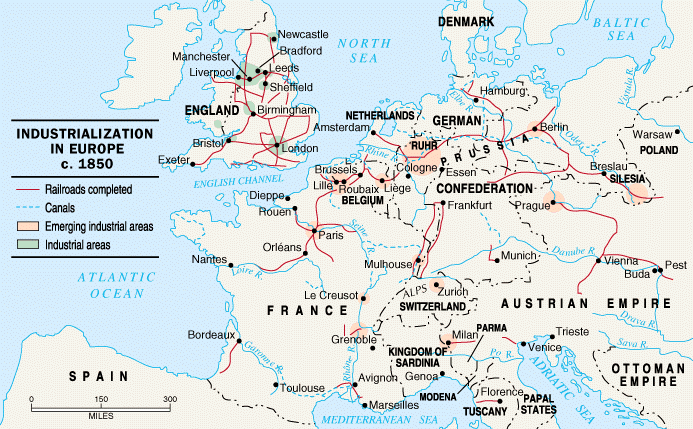
Industrialization
in Europe 1850
|
|
"Every individual is continually
exerting himself to find out the most advantageous employment for
whatever capital he can command. It is his own advantage, indeed, and
not that of society, which he has in view. But the study of his own
advantage, naturally or necessarily, leads him to prefer that
employment which is most advantageous to the society.... By pursuing
his own interest he frequently promotes that of society more
effectually than he intends to promote it.” (Adam Smith, The
Wealth of Nations)
The Great Reform Act (In Our Time) Taking Liberties - 1832 Reform Act British Parliamentary Reform in the 19th Century The Reform Acts (www.victorianweb.org)
Nineteenth
Century Ideologies (excerpted
from An Intellectual History of Modern Europe
by Marvin Perry pp. 203-242)
Nineteenth Century Ideologies Study Guide
The Zeitgeist of the Early 19th Century:
Sophie on Hegel:
History, Dialectic and Progress;
Hegel
in Nieman's Evil
in the Modern World (2002)
Choose Project Groups.
The
Enlightenment philosophes had argued that the application of science
and reason would lead to a better society for all. Did the
extraordinary changes wrought by the Industrial Revolution represent
progress? (Decide as a group whether your definition of progress will
be grounded in a classical liberal, radical liberal or socialist
political philosophy.)
Homework:
Industrial
Revolution Group Projects
Industrial
Revolution Links
Presentation
Ground Rules
|

|

|
|
Spinning
Jenny
by T. E. Nicholson (1835)
|
Industrial
England Early 19th c.
|
|
|
|
|
|
|
|
2
|
25
|
8
|
Fri.
|
|
|
|

The Crystal Palace at The Great Exhibition of 1851
Industrialization and Imperialism:
The Great Exhibition of 1851 (Mosaic)

Child Mine Workers (1820's)

Dore, from London: A Pilgrimage (1872)

Manchester
Factory Kids (1836)
|
|
Nineteenth
Century Ideologies (excerpted
from An Intellectual History of Modern Europe
by Marvin Perry pp. 203-242)
Nineteenth Century Ideologies Study Guide; (Quiz)
"No society can surely be flourishing and happy,
of which the far greater part of the members are poor and miserable."
(Adam Smith)
The Zeitgeist of the Early 19th
Century: Hegel: History,
Dialectic and Progress; Sophie on Hegel;
Hegel
in Notes on Nieman's Evil
in the Modern World (2002)
The
Enlightenment philosophes had argued that the application of science
and reason would lead to a better society for all. Did the
extraordinary changes wrought by the Industrial Revolution represent
progress? (Decide as a group whether your definition of progress will
be grounded in a classical liberal, radical liberal or socialist
political philosophy.)
Develop a
provisional Class Thesis Statement, and then apply the thesis statement
to your group's section of the class presentation. Write a topic
sentence for your group's section of the class presentation.
Homework:
Industrial
Revolution Group Projects
Industrial
Revolution Links
Presentation
Ground Rules
|
|
|
|
|
|
|
2
|
28
|
9
|
Mon.
|
|
|
|

Eiffel Tower (1889)
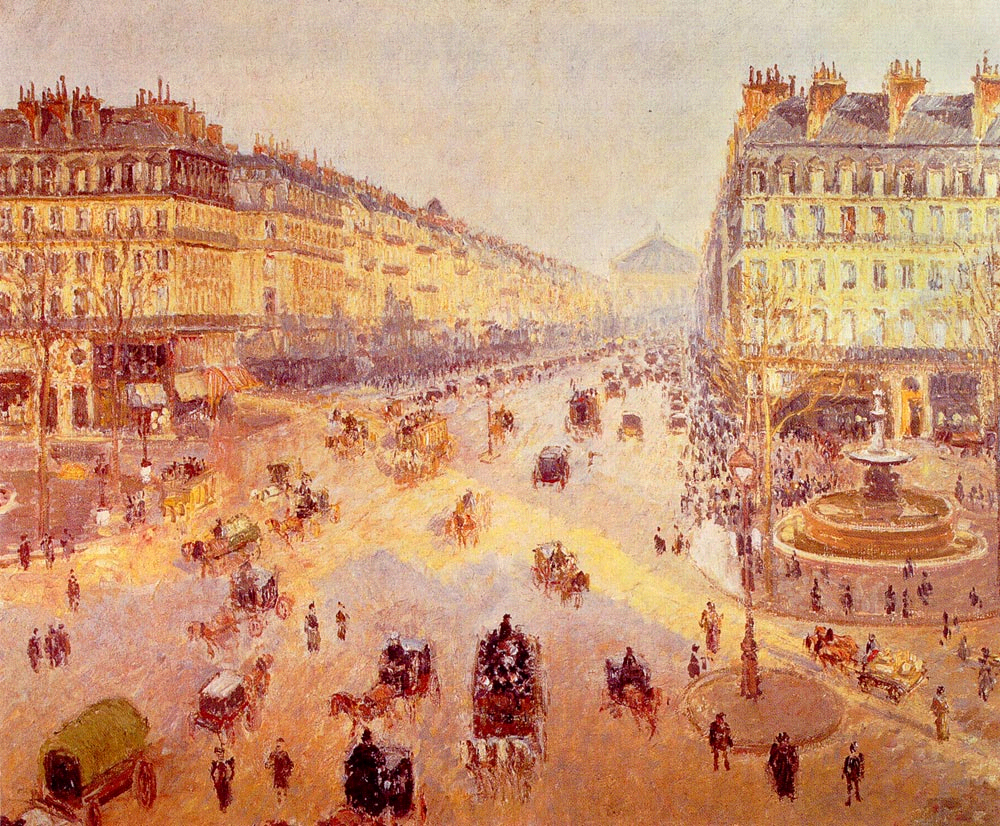
Pissaro, "L'avenue de l'Opera, Sunlight,
Winter Morning."
(1898)

Manet, A Bar at the
Folies-Bergeres
(1881-82)

Renoir, The Luncheon of the
Boating Party (1881)
|
|
The Zeitgeist of the Early 19th
Century: Hegel: History,
Dialectic and Progress; Sophie on Hegel;
Hegel
in Notes on Nieman's Evil
in the Modern World (2002)
The
Enlightenment philosophes had argued that the application of science
and reason would lead to a better society for all. Did the
extraordinary changes wrought by the Industrial Revolution represent
progress? (Decide as a group whether your definition of progress will
be grounded in a classical liberal, radical liberal or socialist
political philosophy.)
Industrial Revolution Group Projects
Industrial
Revolution Links
Presentation
Ground Rules
Test Questions: (Be prepared to answer these
questions from the points of view of a Conservative, a Classical
Liberal, a Radical Liberal or a Socialist.)
- What were the causes of the Industrial
Revolution in England?
- How did innovations in technology and
business practice revolutionize the production and marketing of goods?
How were these innovations financed?
- What impact did the new economy have on
the lives (job security, work conditions, housing, health) of English
workers? Did Adam Smith's "invisible hand" create a just society?
- How did England avoid a workers'
revolution? What did workers do to exert pressure on the factory owners
and the government in order that have their grievances heard? What
political and legislative changes resulted from this debate?
- How was the ideological debate about the
problem of urban poverty reflected in the popular culture of late 19th
c. England?
Homework:
Industrial
Revolution Group Projects
Industrial
Revolution Links
Presentation
Ground Rules
|
|
3
|
1
|
10
|
Tues.
|
|
|
|

Gustave Dore, Houndsditch (1872)
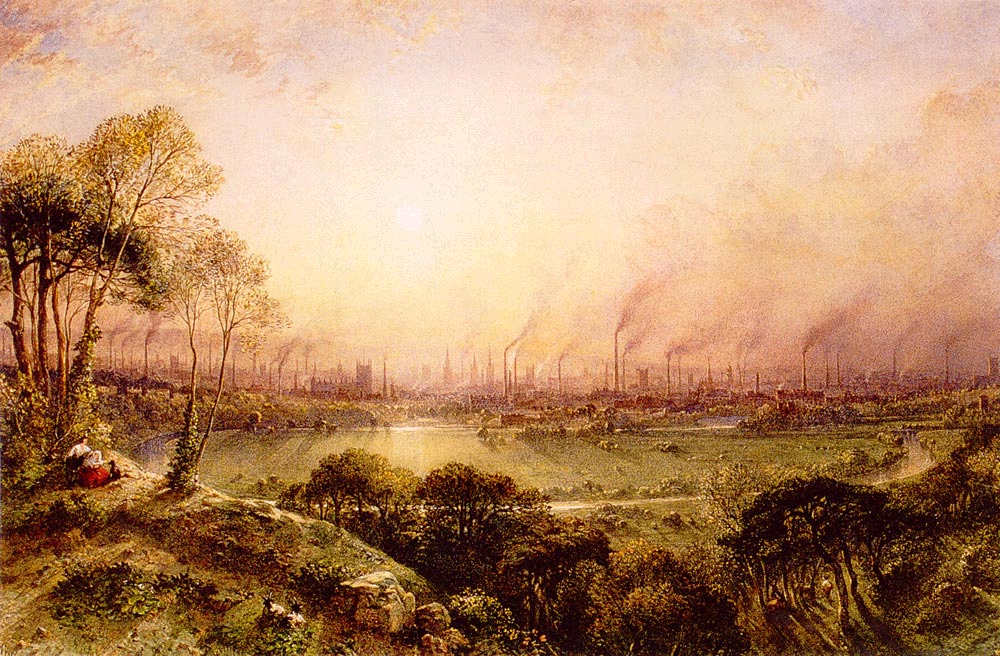
Manchester
1851
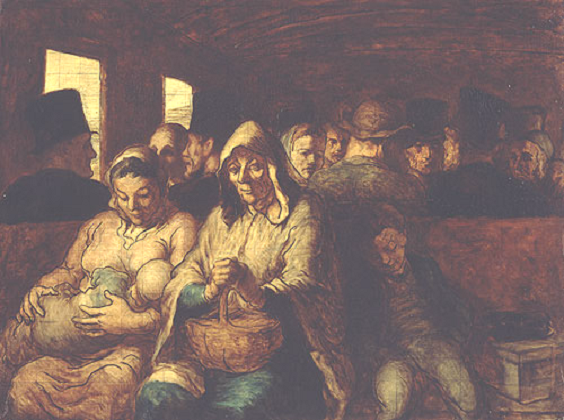
Daumier, The
Third-Class Carriage, (1862)

Daumier, The Uprising (1860)

Dore "The Terraces" from London
(1860)
|
|
Industrial
Revolution Group Projects
Industrial
Revolution Links
Presentation
Ground Rules
Past
Thesis Statements
The
Enlightenment philosophes had argued that the application of science
and reason would lead to a better society for all. Did the
extraordinary changes wrought by the Industrial Revolution represent
progress? (Decide as a group whether your definition of progress will
be grounded in a classical liberal, radical liberal or socialist
political philosophy.)
Thesis:
|
- Remember that
your topic sentence must be directly related to our thesis.
- Think about transitions between your presentation and your partner's
presentation.
- Think about transitions between your group and the next group.
- Remember to quote your texts and to cite your sources.
|
Homework:
|
| 3 |
2 |
1 |
Wed. |
|
|
|

Darby
and Pritchard, Iron Bridge at Coalbrookdale, (1779)

The Crystal Palace at The Great Exhibition of 1851

Ringling
Brothers Barnum and Bailey Poster (1885)
|
|
Industrial
Revolution Group Projects
Industrial
Revolution Links
Presentation
Ground Rules
Test Questions: (Be prepared to answer these
questions from the points of view of a Conservative, a Classical
Liberal, a Radical Liberal or a Socialist.)
- What were the causes of the Industrial
Revolution in England?
- How did innovations in technology and
business practice revolutionize the production and marketing of goods?
How were these innovations financed?
- What impact did the new economy have on
the lives (job security, work conditions, housing, health) of English
workers? Did Adam Smith's "invisible hand" create a just society?
- How did England avoid a workers'
revolution? What did workers do to exert pressure on the factory owners
and the government in order that have their grievances heard? What
political and legislative changes resulted from this debate?
- How was the ideological debate about the
problem of urban poverty reflected in the popular culture of late 19th
c. England?
Homework:
Finish
Group Essay
|
|
|
|
|
|
|
3
|
3
|
2
|
Thurs.
|
|
|
|
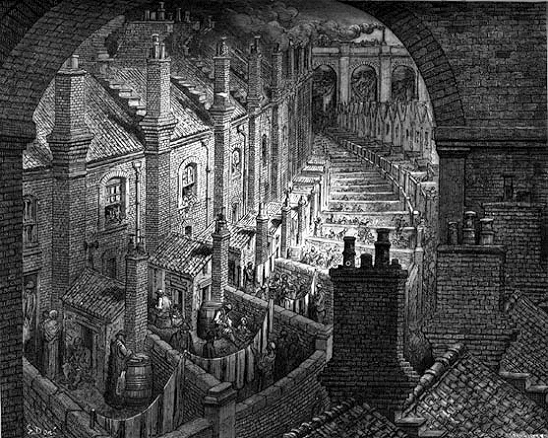
from Gustave
Dore's London (1860)
 Daumier, The
Uprising (1860)
Daumier, The
Uprising (1860)
|
|
Industrial
Revolution Presentations:
Test Questions: (Be prepared to answer these
questions from the points of view of a Conservative, a Classical
Liberal, a Radical Liberal or a Socialist.)
- What were the causes of the Industrial
Revolution in England?
- How did innovations in technology and
business practice revolutionize the production and marketing of goods?
How were these innovations financed?
- What impact did the new economy have on
the lives (job security, work conditions, housing, health) of English
workers? Did Adam Smith's "invisible hand" create a just society?
- How did England avoid a workers'
revolution? What did workers do to exert pressure on the factory owners
and the government in order that have their grievances heard? What
political and legislative changes resulted from this debate?
- How was the ideological debate about the
problem of urban poverty reflected in the popular culture of late
19thc. England?
Homework:
|
|
|
|
|
|
|
3
|
4
|
3
|
Fri
|
|
|
|

Edgar Allan Poe (1809-1849)

Goya, The sleep of reason produces
monsters 1797

Dore "The Terraces" from London
(1860)
|
|
Industrial
Revolution Presentation 2008
Test Questions: (Be prepared to answer these
questions from the points of view of a Conservative, a Classical
Liberal, a Radical Liberal or a Socialist.)
- What were the causes of the Industrial
Revolution in England?
- How did innovations in technology and
business practice revolutionize the production and marketing of goods?
How were these innovations financed?
- What impact did the new economy have on
the lives (job security, work conditions, housing, health) of English
workers? Did Adam Smith's "invisible hand" create a just society?
- How did England avoid a workers'
revolution? What did workers do to exert pressure on the factory owners
and the government in order that have their grievances heard? What
political and legislative changes resulted from this debate?
- How was the ideological debate about the
problem of urban poverty reflected in the popular culture of late 19th
c. England?
Homework:
|
|
|
|
|
|
|
3
|
7
|
4
|
Mon
|
|
|
|
)
Basil Rathbone
as Sherlock Holmes



|
|
Industrial Revolution Group Projects
Industrial
Revolution Links
Presentation
Ground Rules
Test Questions: (Be prepared to answer these
questions from the points of view of a Conservative, a Classical
Liberal, a Radical Liberal or a Socialist.)
- What were the causes of the Industrial
Revolution in England?
- How did innovations in technology and
business practice revolutionize the production and marketing of goods?
How were these innovations financed?
- What impact did the new economy have on
the lives (job security, work conditions, housing, health) of English
workers? Did Adam Smith's "invisible hand" create a just society?
- How did England avoid a workers'
revolution? What did workers do to exert pressure on the factory owners
and the government in order that have their grievances heard? What
political and legislative changes resulted from this debate?
- How was the ideological debate about the
problem of urban poverty reflected in the popular culture of late 19th
c. England?
Nineteenth Century Short Stories:
Poe Creative Writing
Homework:
Sherlock Holmes: The Liberal Super
Hero
Read: Sir Arthur Conan Doyle, Sherlock Holmes and "The
Adventure of the Speckled Band"(1892) (Speckled
Band Links) or "The
Final Problem " (1893) (Final
Problem Links)
Holmes
Links
For further
reading:
· Samuel
Smiles, Self-Help
(1859)
|
|
|
|
|
|
|
3
|
8
|
5
|
Tues.
|
|
|
|
|

from The Adventure of the Speckled Band
(1892)illustrated by Sidney Paget


The
Death of Sherlock Holmes from "The Final Problem" (1893) illustrated by Sidney Paget
|
|
Sir
Arthur Conan Doyle (biographical sketch)
Sherlock Holmes: The Liberal Super Hero
Homework:
Nikolai Gogol, "The
Nose" (1846)
"Nose"
Guide
"Nose"
Outline
For further reading;
Intro to
Russian History (ppt)
|
|
|
|
|
|
|
3
|
9
|
6
|
Wed
|
|
|
|

Nikolai Gogol
(1809-1852)

Illustrations
to The Nose (by
Gennadii Spirin)
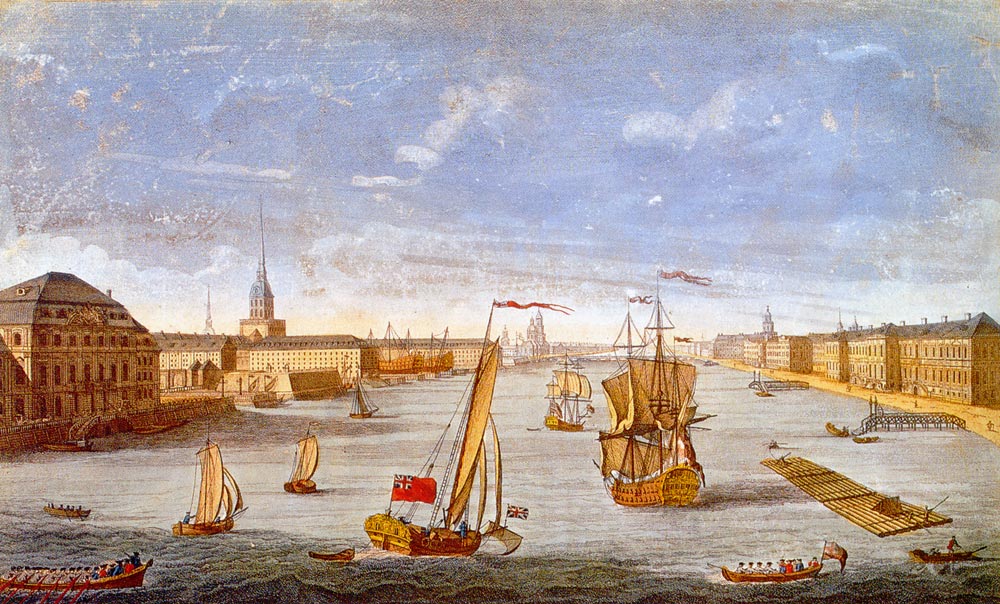
St. Petersburg
1760


|
|
Final Draft
of Industrial Rev Essay 2011
"I am
destined by the mysterious powers to walk hand in hand with my strange
heroes," wrote Gogol once, "viewing life in all its immensity as it
rushes past me, viewing it through laughter seen by the world and tears
unseen and unknown by it."
Nikolai Gogol, "The Nose" (1846)
"Nose"
Guide
"Poshlust"
Towards an artifacts essay on Gogol and the zeitgeist
of mid 19th
Century Russia:
Intro
to Russian History (ppt)
Gogol, "The Overcoat " (1842),
Belinsky, "Letter
to Gogol" (1846) (Notes)
Homework:
|
Creative Writing:
Holmes, Poe and Gogol
Write a story on "Sherlock Holmes and the Case of
the Missing Nose"
|
 The Nyevsky Prospekt in St. Petersburg
The Nyevsky Prospekt in St. Petersburg
|
|
|
|
|
|
|
3
|
10
|
Day 7
|
Thurs
|
|
|
|

Karl Marx 1818-1883

Sigmund Freud 1856-1939
|
|
Industrial Revolution Essay
(Final Draft)
2011
Humanities Essay
Modern
Consciousness:
Homework:
|
The Test of
Liberalism:
Intellectual Backgrounds:
Marx, Freud, Darwin and Nietzsche
Presentations:
the Intellectual Backgrounds to Modern Consciousness
|
|
|
3
|
11
|
8
|
Fri.
|
|
|
|
|

Charles Darwin 1809-1882

Freiderich Nietzsche 1844-1900
|
|
2011
Humanities Essay
The Test of
Liberalism:
Intellectual Backgrounds:
Marx, Freud, Darwin and Nietzsche
Presentations: the Intellectual Backgrounds to
Modern Consciousness
|
|
|
|
|
|
| 3 |
12 |
Day
0 |
Sat. |
Spring Break |
|
3
|
21
|
Day 0
|
Mon
|
Spring
Break |
|
|
|
|
|
| 3 |
22 |
Day
9 |
Tues.
|
|
|
|
 Charles Darwin
1809-1882
Charles Darwin
1809-1882  Freiderich
Nietzsche 1844-1900
Freiderich
Nietzsche 1844-1900 |
|
The Test of
Liberalism:
Intellectual Backgrounds:
Marx, Freud, Darwin and Nietzsche
The Intellectual Backgrounds to Modern
Consciousness
Homework: Prepare for Quiz
|
|
|
|
|
|
|
3
|
23
|
Day 10
|
Wed.
|
|
|
|

The
Rhodes Colossus
Punch 1892
(Getty Images)

"New Crowns for Old Ones" John Tenniel Punch 15
April 1876 (Victorian Web)
|
|
Quiz
on Backgrounds to Modern Consciousness
Homework:
For further reading:
|
|
|
|
|
|
|
|
3
|
24
|
Day 1
|
Thurs.
|
|
|
|

British
Expansion in India (1805-1885)

Imperialism in
South East Asia

European
Imperialism in Asia (1907)

The British Empire in 1914
The British Empire
(Luscombe) (clickable map)

Colonial
Africa
Incredible Map Sites
“Rule Britannia” (the Anthem)
|
|
The New Imperialism:
Homework:
The
New Imperialism (New England College)
Imperialism Map Work: The World in 1914
World
Maps (Civilization in the World)
World
Map (History Teacher)
Map: Age
of Imperialism
Further reading:
|
|
|
|
|
|
|
3
|
25
|
Day 2
|
Fri.
|
|
|
|
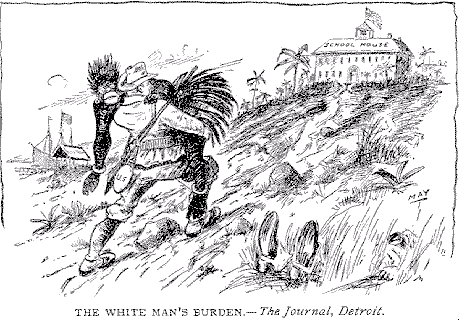
"The White Man's Burden" Detroit Journal,
Feb. 1899, reprinted in Literary Digest (Feb. 18,
1899)

Colonial
Africa
Jeffrey Taylor traveling up the
Congo in 1995 Congo Claims 1000 Lives Daily (PBS)
|
|
The New Imperialism:
Homework:
For Further Reading:
|
|
|
|
|
|
|
|
3
|
28
|
Day 3
|
Mon.
|
|
|
|

The
Rhodes Colossus
Punch 1892
(Getty Images)

From Dobbertin,
Walther. Ca. 1906
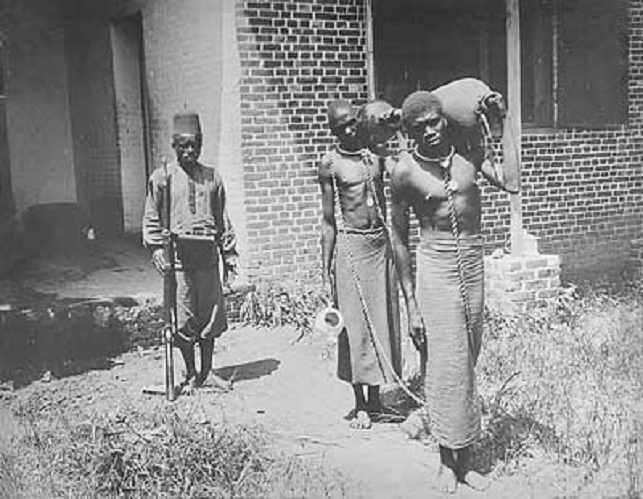
Prisoners
at work, Belgian Congo c. 1912
|
|
The New
Imperialism:
Essay
on Conrad's Heart of Darkness due
Thursday,
April 7th at 3:30 p.m.
The New Imperialism:
Introduction to Conrad
(Powerpoint) and Heart
of Darkness
Homework:
|
|
|
|
|
|
|
|
3
|
29
|
Day 4
|
Tues.
|
|
|
|

Africa in 1885 from Black's Atlas of the World

The Thames from London to the sea

The Thames at Gravesend
|
|
“Fleeing
Rebels Kill Hundreds of Congolese” (NY
Times 3-28-10)
Essay
on Conrad's Heart of Darkness due
Thursday,
April 7th at 3:30 p.m.
Heart of
Darkness:
Lesson Plan One:
Marlow, the Un-named Narrator and
Conrad's Intricate Frame for Heart of Darkness
Body Paragraph One: Conrad's
Intricate Frame
- historic
voyages that have left from Gravesend (4-5)
- Marlow
(5-6)
- a 'nutshell'
(6)
- Romans venture into the 'darkness'
(6-7)
- the 'idea' which
justifies conquest (7)
Homework:
Heart of Darkness
(Reading
Two, pp. 22-39; pp. 6-16; 9-23)
Study
Guide Two
Conrad
Critical Resources
For
further Reading: Racial
Attitudes in Victorian England (Victorian Web) Newman on The British
Gentleman (Victorian Web); Stereotypes of
Africa and Africans in the Late 19th Century European Imagination
(Powerpoint)
|
|
3
|
30
|
Day 5
|
Wed.
|
|
|
|
|
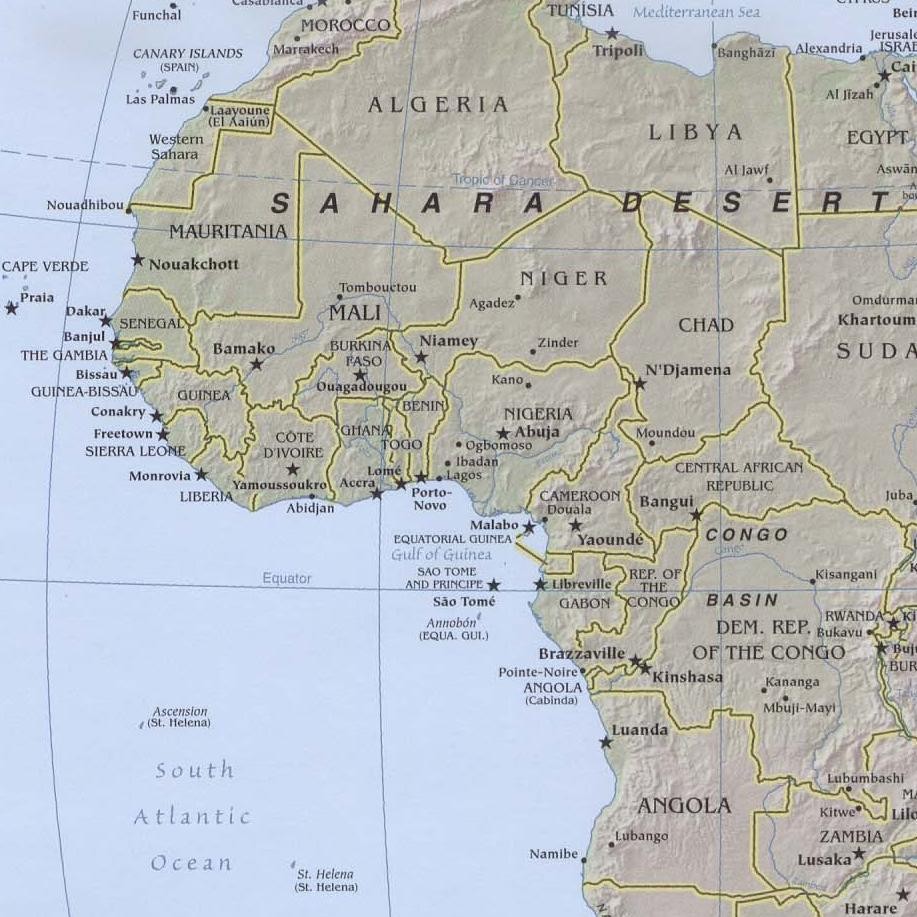
West Africa

Leopoldville:
The Outer Stations
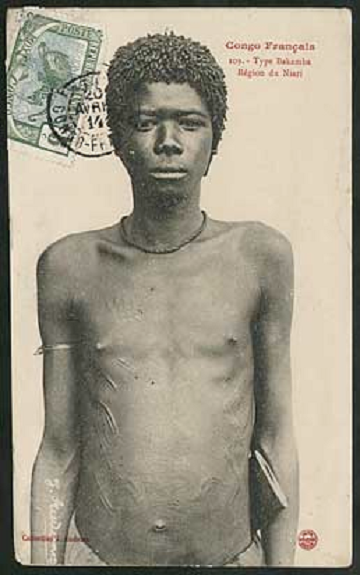
Kamba "type," Niari River region, French Congo Jean Audema c. 1900,
postcard
|
|
Essay
on Conrad's Heart of Darkness due
Thursday,
April 7th at 3:30 p.m.
Body Paragraph One: Conrad's
Intricate Frame
- historic
voyages that have left from Gravesend (4-5)
- a 'nutshell'
(6)
- Marlow
(5-6)
- Romans venture into the 'darkness'
(6-7)
- the 'idea' which
justifies conquest (7)
Heart
of Darkness: (Reading Two) Lesson
Plan Two (Quiz)
Body
Paragraph Two: Symbols as Signposts on the Trail of Kurtz
- the snake of the
Congo River (8)
- the sad fate of Captain
Fresleven (6) (10)
- knitting
women beside the great map
of Africa (7-8) (11)
- the
doctor and his secret theory
(9) (13-14)
- the Africans
(10) (16)
- the French warship
(11) (16)
Body
Paragraph Three: The
Outer Station
-
a Swede
(12) (17)
- first
impressions (12) (17)
- the chain
gang (13-14) (18)
- the
grove of trees (14) (19-20)
- the
Chief Accountant (15-16) (21)
- first mention of Kurtz
(15-16) (22)
5th
Period: Film: The Outer Station in Apocalypse Now (1979)
Homework:
Heart of Darkness (Reading Three
pp. 38-59 pp. 16-26; 22-37)
(Reading Three
continued) Study Guide
Three
|
|
|
|
|
|
|
|
3
|
31
|
Day 6
|
Thurs.
|
|
|
|
 Leopoldville:
The Outer Station
Leopoldville:
The Outer Station
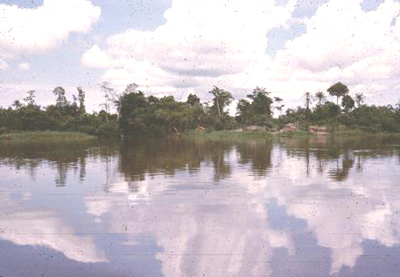

The Congo

Fisherman pole their boat out into the Congo River (ca. 1950).
CORBIS/Otto Lang.
|
|
Essay
on Conrad's Heart of Darkness due
Thursday,
April 7th at 3:30 p.m.
Body Paragraph One: Conrad's
Intricate Frame
- historic
voyages that have left from Gravesend (4-5)
- a 'nutshell'
(6)
- Marlow
(5-6)
- Romans venture into the 'darkness'
(6-7)
- the 'idea' which
justifies conquest (7)
Heart of Darkness: (Reading
Two) Lesson
Plan Two
Body
Paragraph Two: Symbols as Signposts on the Trail of Kurtz
- the snake of the
Congo River (8)
- the sad fate of Captain
Fresleven (6) (10)
- knitting
women beside the great map
of Africa (7-8) (11)
- the
doctor and his secret theory
(9) (13-14)
- the Africans
(10) (16)
- the French warship
(11) (16)
Body
Paragraph Three: The
Outer Station
-
a Swede
(12) (17)
- first
impressions (12) (17)
- the chain
gang (13-14) (18)
- the
grove of trees (14) (19-20)
- the
Chief Accountant (15-16) (21)
- first mention of Kurtz
(15-16) (22)
Body Paragraph Four: The Middle
Station
- The Trek
(16-17) (22-23)
- Marlow's white
companion (17) (23)
- the
sunken steamer (18) (25)
- the General
Manager (19-20) (25-26)
- the pilgrims
(20) (27)
- the 'paper-mache
Mephistopholes'
- Kurtz's
painting (21-22) (30)
- Imagining
Kurtz (23) (32)
- Marlow breaks
off his story (24) (32-33)
Body Paragraph Five: The Overheard
Conversation (27-29)
Homework:
Heart
of Darkness (Reading Four
pp. 59- 86; 27-47; 38-64)
(Notes)
Study
Guide Four
For
further Reading: Racial
Attitudes in Victorian England (Victorian Web) Newman on The British
Gentleman (Victorian Web); Stereotypes of
Africa and Africans in the Late 19th Century European Imagination
(Powerpoint)
|
|
|
|
|
|
|
|
4
|
1
|
Day 7
|
Fri.
|
|
|
|

The Congo
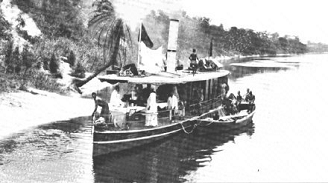
Congo Riverboat

Fisherman pole their boat out into the Congo River (ca. 1950).
CORBIS/Otto Lang.
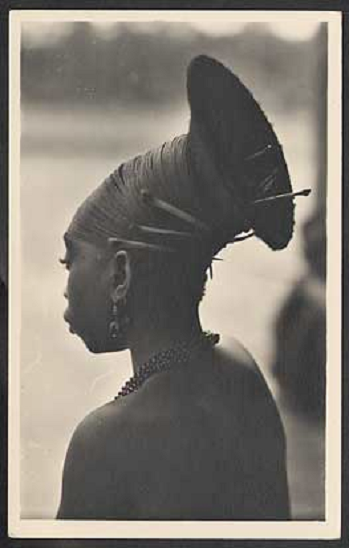

|
|
Essay
on Conrad's Heart of Darkness due
Thursday,
April 7th at 3:30 p.m.
Body Paragraph One: Conrad's
Intricate Frame
- historic
voyages that have left from Gravesend (4-5)
- a 'nutshell'
(6)
- Marlow
(5-6)
- Romans venture into the 'darkness'
(6-7)
- the 'idea' which
justifies conquest (7)
Heart of Darkness: (Reading
Two) Lesson
Plan Two
Body
Paragraph Two: Symbols as Signposts on the Trail of Kurtz
- the snake of the
Congo River (8)
- the sad fate of Captain
Fresleven (6) (10)
- knitting
women beside the great map
of Africa (7-8) (11)
- the
doctor and his secret theory
(9) (13-14)
- the Africans
(10) (16)
- the French warship
(11) (16)
Body
Paragraph Three: The
Outer Station
-
a Swede
(12) (17)
- first
impressions (12) (17)
- the chain
gang (13-14) (18)
- the
grove of trees (14) (19-20)
- the
Chief Accountant (15-16) (21)
- first mention of Kurtz
(15-16) (22)
Body Paragraph Four: The Middle
Station
- The Trek
(16-17) (22-23)
- Marlow's white
companion (17) (23)
- the
sunken steamer (18) (25)
- the General
Manager (19-20) (25-26)
- the pilgrims
(20) (27)
- the 'paper-mache
Mephistopholes'
- Kurtz's
painting (21-22) (30)
- Imagining
Kurtz (23) (32)
- Marlow breaks
off his story (24) (32-33)
Body Paragraph Five: The Overheard
Conversation (27-29)
Body Paragraph Six:
The Voyage to the Inner Station Study Guide
Four
- The
Voyage Up River (30) (41)
- The
Fireman (33) (45)
- The
Strange Message in the Hut (64) (33) (45)
- The
Silent Fog, the Cry
of Infinite Desolation, and the
Cannibals (67-68) (72) (35-36)
(48-49)
- The
Hail of Arrows 'they looked like they wouldn't kill a cat' (41)
(76) (55)
- The
Death of the Helmsman (78) (42) (57)
- The Look on the Helmsman's Face at the Moment
of Death (84) (42-43) (62-63)
- Marlow's Frenzied Change of Shoes (79) (43) (57-58)
- Marlow's Sudden Realization of the
Secret of Kurtz's Power (79) (43) (61)
- Kurtz's
Essay for the International Society for the Suppression of
Savage Customs (83) (45-46) (61)
- Arrival at the Inner Station and the Encounter with Kurtz's Fool
(87) (48) (64-65)
Homework:
Heart of Darkness, Reading Five,
(pp. 87- 108; 47-67; 64-83)
The Inner Station Study
Guide Five
For
further Reading: Racial
Attitudes in Victorian England (Victorian Web) Newman on The British
Gentleman (Victorian Web); Stereotypes of
Africa and Africans in the Late 19th Century European Imagination
(Powerpoint)
|
|
|
|
|
|
|
4
|
4
|
Day 8
|
Mon.
|
|
|
|
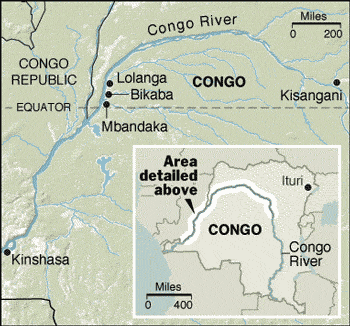
The Congo River

Jim Jones and the Guyana Tragedy: "White Night" final recording from Jonestown.
Conversation and ambient sound. 1978. (Transcript)
|
|
Essay
on Conrad's Heart of Darkness due
Thursday,
April 7th at 3:30 p.m.
Body Paragraph Six:
The Voyage to the Inner Station Study Guide
Four
- The
Voyage Up River (30) (41)
- The
Fireman (33) (45)
- The
Strange Message in the Hut (64) (33) (45)
- The
Silent Fog, the Cry
of Infinite Desolation, and the
Cannibals (67-68) (72) (35-36)
(48-49)
- The
Hail of Arrows 'they looked like they wouldn't kill a cat' (41)
(76) (55)
- The
Death of the Helmsman (78) (42) (57)
- The Look on the Helmsman's Face at the Moment
of Death (84) (42-43) (62-63)
- Marlow's Frenzied Change of Shoes (79) (43) (57-58)
- Marlow's Sudden Realization of the
Secret of Kurtz's Power (79) (43) (61)
- Kurtz's
Essay for the International Society for the Suppression of
Savage Customs (83) (45-46) (61)
- Arrival at the Inner Station and the Encounter with Kurtz's Fool
(87) (48) (64-65)
Body Paragraph Seven:
Kurtz and The Inner Station
(Reading
Five) Study
Guide Five
- Kurtz's
Court Jester (48-49) (64-69)
- The
Fool on Kurtz (51-52) (69-70)
- The
Heart of Darkness (54-55) (73-74)
- Marlow
Wrestles with Kurtz (58-59) (79-82)
Homework:
Heart
of Darkness: (Reading Six
pp. 108- 124; 61-72; 83-95)
Study
Guide Six
For further
reading:
- Chinua Achebe on Heart
of Darkness
- "Out of
Africa": Caryl Philips vs. Chinua Achebe on Conrad as Racist
(Guardian 2/22/03)
- Conrad Critical
Resources
|
|
|
|
|
|
|
4
|
5
|
Day 9
|
Tues.
|
|
|
|
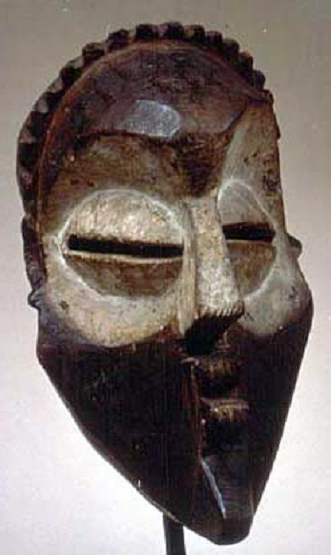
Mask (kibwabwabwa)
Kete or Mbagani peoples, Democratic Republic of the Congo, 19th-20th c.
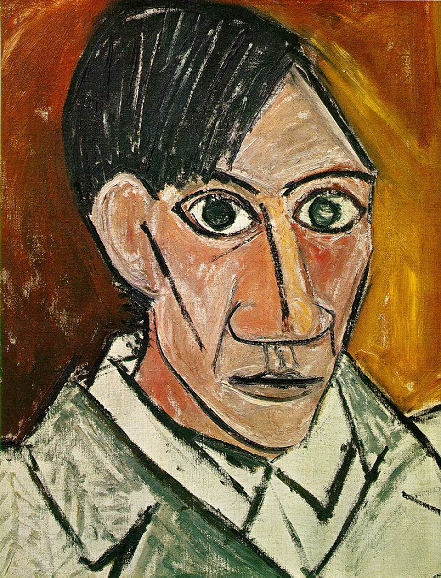
Picasso
Self-Portrait (1907)
|
|
Essay
on Conrad's Heart of Darkness due
Thursday,
April 7th at 3:30 p.m.
Body Paragraph Seven:
Kurtz and The Inner Station
(Reading
Five) Study
Guide Five
- Kurtz's
Court Jester (48-49) (64-69)
- The
Fool on Kurtz (51-52) (69-70)
- The
Heart of Darkness (54-55) (73-74)
- Marlow
Wrestles with Kurtz (58-59) (79-82)
Paragraph Eight: The Return Study Guide Six
- Kurtz's
Death (64) (86-87) (Kurtz's
Essay) (43) (61)
- Marlow's
Illness (65) (87-88)
- Brussels
(65-66) (88-90)
- The
Intended (68-71) (92-95)
- Final
Image (72) (96)
Conclusion: IS progress
possible?
Homework:
Essay
on Conrad's Heart of Darkness due
Thursday,
April 7th at 3:30 p.m.
Heart
of Darkness Outline
|
|
|
|
|
|
|
4
|
6
|
Day 10
|
Wed.
|
FCD |
|
|

Monet, Impression, Sunrise
(1872)

Ernst, The
Beautiful Season (1925)

Duchamp, Bicycle Wheel (1913)
|
|
Modern
Art: The Revolt Against Representation (ppt.)
The
Zeitgeist of Modernism
Humanities
Artifacts Site
The Test of
Liberalism: Intellectual Backgrounds:
Marx, Freud, Darwin and Nietzsche
Homework:
Choose an Artifacts Essay Topic: Humanities
Artifacts Site
 |
| Renoir, The Luncheon of the Boating Party (1881) |
|
|
|
|
|
|
|
4
|
7
|
Day 1
|
Thurs.
|
|
|
|
|

Europe 1898

Austria-Hungary 1898
|
|
Essay on Conrad's Heart
of Darkness due Thursday,
April 7th at 3:30 p.m.
Introduction
to The Metamorphosis (1912) by Franz Kafka
Czech-ing Account
(A History of Czechoslovakia)
Czech-ing
Account (notes)
Czech History Maps
(Powerpoint)
Homework:
|
|
|
|
|
|
|
|
4
|
8
|
Day 2
|
Fri.
|
|
|
|

Franz
Kafka in 1915

Prague Ghetto 1898
|
|
Czech-ing
Account (notes)
Czech History
Maps (Powerpoint)
Kafka's
Metamorphosis: part one (notes)
Quiz 1
Discussion questions:
- Why
has Gregor turned into a bug?
- Might
Gregor have unconsciously chosen this route?
- What
pressures in Gregor’s life have driven him to such a desperate measure?
- Did he
have any other options?
Look for clues in the details of the text for answers to these
questions.
Homework:
The Metamorphosis
by Franz Kafka, part
two Study Guide
|
|
|
|
|
|
|
|
4
|
11
|
Day 3
|
Mon.
|
|
|
|

Max Beckmann, Family Picture, 1920,
Sprengel Museum: Germany

from Vladimir Nabokov's copy
of The Metamorphosis (Nabokov's Lecture)
|
|
Kafka's
Metamorphosis: part two (notes) Quiz 2
(Gregor
Freaks Out)
Discussion questions:
- Can
Gregor be saved?
- What
habits drove Gregor into this terrible situation?
- Has
the metamorphosis changed his pattern of behavior?
- How
does the family adapt to Gregor's metamorphosis?
Homework:
The
Metamorphosis by Franz Kafka, part three
Study
Guide
Kafka's
Metamorphosis, part three (notes) Quiz 3
- What
causes Gregor’s death?
- Why
has Gregor’s radical strategy failed?
What was his original goal? Why did it go so terribly awry?
- How
has the family adjusted financially and emotionally to Gregor’s strange
transformation?
Essay Questions:
1. What does The
Metamorphosis teach us about the dangers of the developmental
hurdles that we all must face as we enter adulthood?
2. Also, how does The Metamorphosis describe the
political situation of the Central European Jew in the years leading to
the great wars of the first half of the twentieth century?
|
|
|
|
|
|
|
4
|
12
|
Day 4
|
Tues.
|
|
|
|
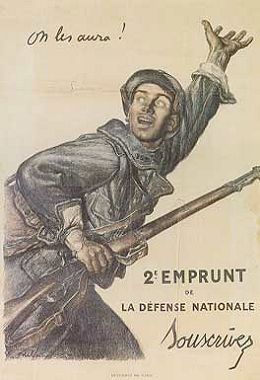
Faivre, "On les aura!" (1916)

Erler, Fritz.
"Help Us Win!" (1917)
|
|
European
Humanities Artifact Project (2010-11)
Introduction
to World War One Poetry
Never
such innocence,
Never before or since,
As changed itself to past
Without a word—the men
Leaving the gardens tidy,
The thousands of marriages
Lasting a little while longer:
Never such innocence again.
—Philip Larkin, MCMXIV
Homework:
|
|
|
|
|
|
|
|
4
|
13
|
Day 5
|
Wed.
|
|
|
|


John Nash, Over
the Top,
Imperial War Museum, London.
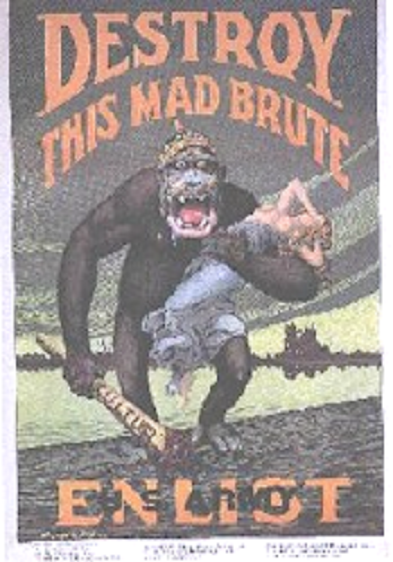
|
|
Fussell Quiz
The Grand
Illusion: Poetry from Before the War
Alfred Lord Tennyson: "The Charge of the
Light Brigade"
Robert Browning: "Home-Thoughts,
From Abroad"
Henry Newboldt: "Vitai
Lampada"; "Clifton
Chapel"
Rudyard Kipling: "Danny
Deever"; "Tommy";
"Recessional";
"Shillin’
a Day"; Gunga
Din
Kubrick, Paths
of Glory (1957): (Clip)
Renoir, Grand Illusion (complete film)
(1937)
Homework:
Paragraph
on poem by Thomas Hardy
For
further reading:
The Battle of Verdun
(ppt.)(Atkinson Barnes) (Quiz)
|
|
|
|
|
|
|
|
4
|
14
|
Day 6
|
Thurs.
|
|
|
|
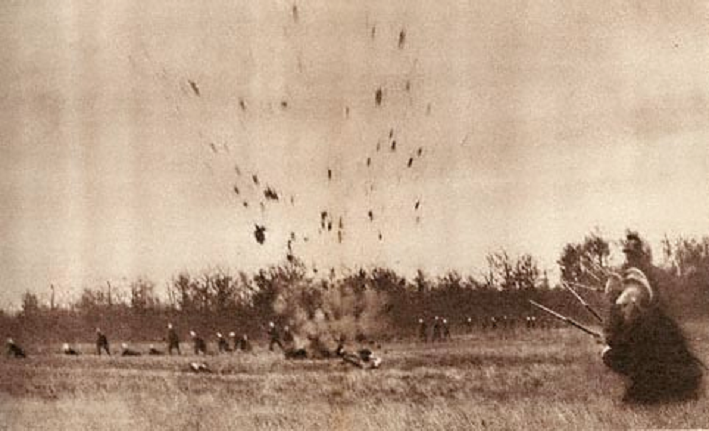
French
Infantry Attack
War
Films: The Battle of the Somme (Mosaic)

Max Beckmann, Die
Granate (Shell), 1915
|
|
Paragraph
on one of the following poems:
Thomas
Hardy, "The
Darkling Thrush", "Drummer Hodge", "The Man He Killed",
"Channel
Firing" (1914)
Homework:
|
|
|
|
|
|
|
|
4
|
15
|
Day 7
|
Fri.
|
|
|
|

Henri
Gaudier-Brzeska, La mitrailleuse en action (The Machine-gun
in Action), 1915, Musée National d'Art Moderne, Paris.
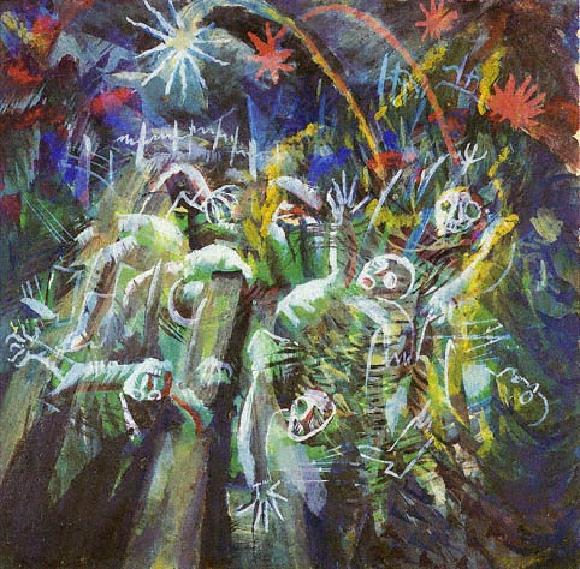
Otto
Dix, Lichtsignale (The Flare), 1917

Ernst, Murdering
Airplane (1920)

Singer Sargent, Gassed (1918)
|
|
|
Poem
Presentation Project
The Reality of Modern War
Prepare 2-3 minute speech on your poem.
Hardy, “Men
Who March Away”
Brooke, "Peace";
"The
Dead"; "The
Soldier"
Asquith, "The
Volunteer"
Read, "The
Happy Warrior"
McCrae, "In
Flanders Fields"
Seeger, "I
Have a Rendezvous With Death";
Owen, "Anthem
for Doomed Youth"; "Disabled"; "Strange
Meeting"
Sassoon, "Exposure",
"A Working
Party"; "Counter-Attack";
"Suicide
in the Trenches"
Adlington, "Bombardment"
Rosenberg, "Break
of Day in the Trenches"
|
Homework:
|
|
|
|
|
|
|
4
|
18
|
Day 8
|
Mon.
|
|
|
|
Artifacts Site:
World War I
Art of World
War One
World War
One Posters.

Singer Sargent,
Death and
Victory (1922)

Kirchner, Selbstbildnis
als Soldat (1915)
|
|
Poem
Presentation Project
The
Reality of Modern War
Prepare 2-3 minute speech on your poem.
Hardy, “Men
Who March Away”
Brooke, "Peace";
"The
Dead"; "The
Soldier"
Asquith, "The
Volunteer"
Read, "The
Happy Warrior"
McCrae, "In
Flanders Fields"
Seeger, "I
Have a Rendezvous With Death";
Owen, "Anthem
for Doomed Youth"; "Disabled"; "Strange
Meeting"
Sassoon, "Exposure",
"A
Working Party"; "Counter-Attack";
"Suicide
in the Trenches"
Adlington, "Bombardment"
Rosenberg, "Break
of Day in the Trenches"
Homework:
|
|
|
|
|
|
|
|
4
|
19
|
Day 9
|
Tues.
|
|
|
|

Picasso, Portrait of
Gertrude Stein (1906)

Katsushika
Hokusai
The
Great Wave Off Kanagawa,
from "Thirty-six Views of Mount Fuji" (1823-29)
|
|
Modernist Poetry:
Gertrude Stein “Susie Asado”; "If I Told Him"
(1914) (audio)
Ezra
Pound and Imagism "In a Station in the Metro" (1913)
The
Haiku of Basho
William Carlos Williams "The
Red Wheelbarrow"; "The Great Figure"
Homework:
|
|
|
|
|
|
|
|
4
|
20
|
Day 10
|
Wed.
|
|
|
|

Aivazovsky, The Ninth Wave, 1850
 Surikov,
The Morning
of the Execution of the Streltsy. 1881 Surikov,
The Morning
of the Execution of the Streltsy. 1881

Repin, Barge Haulers on the Volga (1870)
Tchaikovsky, 1812
Overture
|
|
Nineteenth
Century Russian Radicalism
Towards an artifacts essay on the zeitgeist
of mid 19th
Century Russia:
Russia: 1825-1917
Homework:
Turgenev,
"A Country Doctor" (1855) (Class
Discussion)
For further
study:
The
Russian Revolution Simulation (Spartacus)
Chronology
of Russian History 1825-1919 (Bucknell)
|
|
|
|
|
|
|
|
4
|
21
|
Day 1
|
Thurs.
|
|
|
|
|
 Falconet's Falconet's
Statue of
Peter the Great
(1788)

Nicholas I (1796-1855)

The Countess in
Pushkin’s "The Queen of
Spades"
(1834)

Perov, Feodor
Dostoyevsky 1872
|
|
Backgrounds
to the Russian Revolution (Powerpoint)
Key Events:
Victory
over Napoleon (1812)
The Decembrist Revolt (1815)
Nicholas I: Autocracy, Orthodoxy and Nationalism
The Failed Liberal Revolutions of 1848
The Crimean War (1855)
Alexander II Frees the Serfs (1861)
Assassination of Alexander II (1881)
Repression of Alexander III
The
Impact of 1848
Turgenev,
"A Country Doctor" (1855) (Class
Discussion)
Homework:
Artifacts
Essay Work
For Further Reading:
Literature:
Pushkin, "The Station-master"
(1830); "The Bronze Horseman" (1833);
"The Queen of Spades"
(1834) (selected poetry)
Gogol, "The Overcoat " (1842) "The Nose"
(1846)
Turgenev,
"A Country Doctor"
(1855); A Sportsman's Sketches (1855);
Fathers and Sons
(1861)
Dostoevsky, "The
Most Precious Thing for Man" from Notes from Underground
(1864); "Raskolnikov's Terrible Dream"from
Crime and Punishment
(1865); "The Parable of the Grand
Inquisitor" from The Brothers Karamazov
(1879)
Tolstoy, The Death of Ivan Ilych
(1882)
Politics:
Herzen, Paris
1848, After the June Days"; Introduction;
"A
Voice for the Russian People"
Belinsky, "Letter
to Gogol" (1846); Belinsky
and Gogol Argue Over Russian Destiny (1846)
(Mosaic) Belinsky, (Notes)
Secondary Sources:
Evaluating
1848 (Mosaic)
Isaiah Berlin, Liberty:
Freedom from? or Freedom to?
|
|
|
|
|
|
|
|
4
|
22
|
Day 0
|
Fri.
|
Good Friday
|
| 4 |
25 |
Day
0 |
Mon. |
Professional Day |
|
|
|
|
|
| 4 |
26 |
Day
2 |
Tues. |
|
|
|


Serov,
Lenin (1920)

Poster
for October:
Ten Days That Shook the World (1927)

Red Square: Painterly Realism of a
Peasant Woman in Two Dimensions
(1915) State Museum, St. Petersburg\
Russian
Avant-Garde
Art
|
|
From
Socialism to Marxism to Leninism:
Review: Utopian
Socialists; Marx
and Engels;
Key Events Leading to the Revolution:
Victory over
Napoleon (1812)
The Decembrist Revolt (1815)
Nicholas I: Autocracy, Orthodoxy and Nationalism
The Failed Liberal Revolutions of 1848
The Crimean War (1855)
Alexander II Frees the Serfs (1861)
Assassination of Alexander II (1881)
Repression of Alexander III
The Russo Japanese War (1905)
Revolution of 1905
World War One (1914-17)
February and October Revolutions (1917)
Vladimir
Illych Lenin (1870-1924): “What Is to Be Done?” (1902)
The
Revolutions of 1917 (outline): “What Was Done”
(Julius lecture)
Yeats, “The Second
Coming” (1920)
For further reading:
More Lenin: The
April Theses, (1917); Declaration
of the Rights of the Toiling and Exploited Peoples (1917); On the
Organization of and Extraordinary Commission to Fight Counter Revolution,
Letter to Dzerzhinskii, December 19, 1917 ; Hanging
Order for Kulaks, 11-8-1918
Film: The
Battleship Potemkin (1925) dir. Eisenstein
Homework:
|
|
|
|
|
|
|
|
4
|
27
|
Day 3
|
Wed.
|
|
|
|

Moor, "Have You Volunteered?" Poster. 1920

Tatlin’s Tower (1919) 3-D Model.

Apsit, "A Year of the Proletarian Dictatorship" 1918
Mosaic Links: Russia Under Lenin and Stalin

"For Shock-Brigade Reaping and for a
Bolshevik Harvest." The Collective Farm Voron,
Poster. 1934

Vladimirski, "Roses for Stalin" (1949)
|
|
The Revolutions of 1917
Lenin, “What Is to Be Done?” (1902)
“What Was Done”
(outline)
(Julius lecture)
1905
Revolution
The
February Revolution
The
Provisional Government vs. The Soviets
Lenin’s
April Theses
The
July Days
The
Kornilov Affair
The
October Revolution
The Civil War (1918-1921)
Yeats, “The Second
Coming” (1920)
Alexander Blok, "The
Twelve" (1918)
Isaac Babel, from “The
Dead” (1918)
from Socialism to Marxism
to Bolshevism:
Lenin
(1870-1924): What Is to Be Done? (1902)
The February Revolution (1917)
Order Number 1 (1917)
Lenin, Call
to Power (Oct 24, 1917)
The "Unknown" Lenin (1918)
Russian Avant-Garde
Art
Kazimir
Malvelevich and "Suprematism"
The Soviets Under Stalin:
Socialist
Realism (Powerpoint)
Life's
Getting Better (1934) (Mosaic)
Life
is Not Easy!(1937) Mosaic
Anna Akhmatova, "Requiem"
(1935-61)
For further reading:
And further viewing:
Russia During WWII:
Historical
Interpretations
Homework:
|
|
|
|
|
|
|
|
4
|
28
|
Day 4
|
Thurs.
|
|
|
|

Schinkel,
"Medieval City on a River" (1815)

Hitler at the
Feldherrnhalle,
August 1, 1914
|
|
German
Nationalism:
German
Modernism (notes from "Berlin", in Rites of Spring
by Modris Ecksteins)
German Idealism
The Rise of Modern Germany:
For
further reading:
Congress of
Vienna (1815)
Metternich, from Carlsbad
Decrees
Treaty
of Versailles, June 28, 1919
Versailles
vs. Vienna (Powerpoint)
Intellectual
Backgrounds to Fascism and Communism
A
New Thirty Years War (Mosaic)
Homework:
|
|
|
|
|
|
|
|
4
|
29
|
Day 5
|
Fri.
|
|
|
|

Schinkel,
"Medieval City on a River" (1815)

Europe 1914

The Big 4 met
in Paris to negotiate the Treaty Lloyd George of Britain, Orlando of
Italy, Clemenceau of France, and Woodrow Wilson of the U.S.
|
|
German Nationalism
- Kant:
subjective reality; radical finitude; moral freedom
- Hegel:
determined history; spirit unfolding through conflict
- Herder:
cultural pluralism
- German
Romanticism: values are subject to culture
The Rise of Modern Germany:
Homework:
|
|
|
|
|
|
|
|
5
|
2
|
Day 6
|
Mon.
|
|
|
|

Schinkel,
"Medieval City on a River" (1815)


Grosz,
Der Monteur
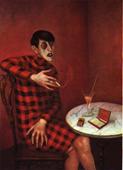
Dix, The
Journalist Sylvia Von Harden (1926)
Expressionism (Pace Powerpoint) user name:
pb20s password: nov1118
|
|
German Nationalism
- Kant:
subjective reality; radical finitude; moral freedom
- Hegel:
determined history; spirit unfolding through conflict
- Herder:
cultural pluralism
- German
Romanticism: values are subject to culture
The Rise of Modern Germany:
The
German Experience of WWI:
The
Weimar Republic (1919-1932)
· The Collapse of
Liberalism
Homework:
Artifacts
Essay Work Easy Bib; Citation Machine; OSLIS Citation Maker
|
|
|
|
|
|
|
|
5
|
3
|
Day 7
|
Tues.
|
|
|
|
|
|
Review for Final Exam
Essay on
The Failure of Liberalism in Germany After World
War One:
|
|
5
|
4
|
Day 8
|
Wed.
|
|
|
|
|

"National
Socialism
or the Sacrifice was in Vain" 1921

"Muzzled" Literary Digest 9/13/1919

The Fagus Shoe Factory, Alfeld-an-der-Leine, Walter Gropius (1910-12)

From Riefenstahl,
Leni. "Triumph of the Will." 1934
|
|
The German Experience of WWI:
The
Weimar Republic and The Rise of Nazism (internet
sources)
The
Weimar Republic: The Collapse of Liberalism (ppt)
The Nazis Seize Power: Weimar
Death Throes
Nazi Ideology: The
25 Points (1920)
Great
Depression Begins - October 29, 1929
Germans
Elect Nazis - September 14, 1930
Success
and a Suicide - 1931
Hitler
Runs for President - 1932
The
Republic Collapses
Hitler
Named Chancellor of Germany - January 30, 1933
The
Reichstag Burns - February 27, 1933
Hitler
Becomes Dictator of Germany - March 23, 1933
For further reading:
Spartacus
Weimar Republic
Chronology
Bruno Heilig, "Why
the German Republic Fell"
(1938)
Homework:
Artifacts Essay Work
Further Reading:
|

|

|

|
|
Schweitzer,
Hans.
"Our Last Hope: Hitler." Poster. 1932
|
Hitler Campaign Poster 1932
|
From Riefenstahl,
Leni.
"Triumph of the Will." Film still. 1934
|
|
|
|
|
|
|
|
|
5
|
5
|
Day 9
|
Thurs.
|
|
|
|
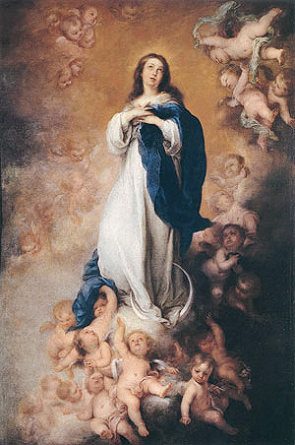
Murillo,
The Immaculate Conception, ca. 1678
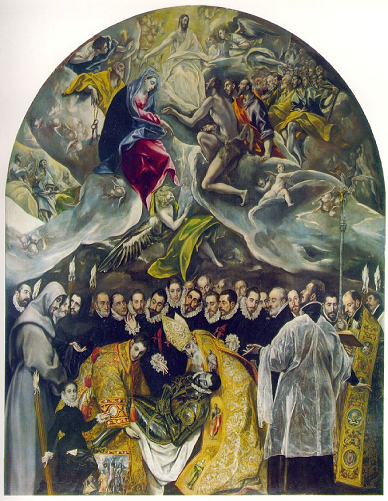
El Greco, The
Burial of Count Orgascz, 1586
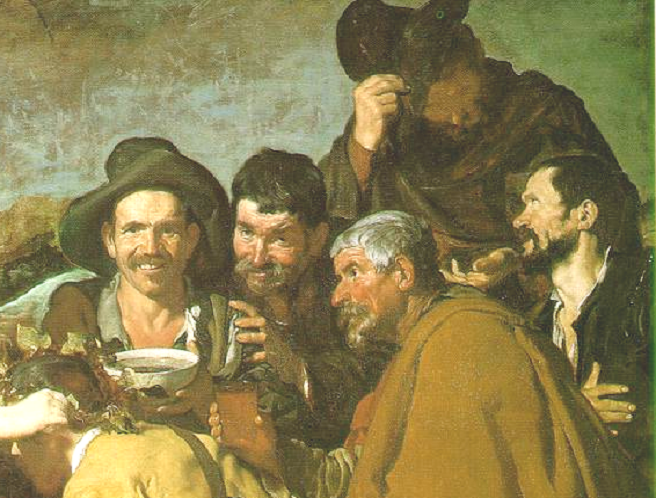
Velazquez,
Diego
The Feast of Bacchus ("Los Borrachos") [detail] 1629
|
|
The
Spanish Civil War:
Homework:
Federico
Garcia Lorca (1898-1936)
From Romancero Gitano (1928)
The
Gypsy and the Wind
The
Faithless Wife
Romance
de la luna, luna
For further reading (and listening):
|
|
|
|
|
|
|
|
5
|
6
|
Day 10
|
Fri.
|
|
|
|

Federico Garcia
Lorca 1898-1936

Sargent, John Singer
El Jaleo 1880

Murillo,
The Immaculate Conception, ca. 1678
|
|
The
Spanish Imagination: El Greco, Velazquex, Goya, Picasso,
Dali, Miro (ppt)
Ravel, Alborada
del gracioso (1918); Bolero
(1928) Flamenco
Guitar
Federico
Garcia Lorca (1898-1936)
From Romancero Gitano (1928)
The
Gypsy and the Wind
The
Faithless Wife
Romance
de la luna, luna
Lament
for Ignacio Sanchez Mejias (1934)
Homework:
|
|
|
|
|
|
|
|
5
|
9
|
Day 1
|
Mon.
|
|
|
|
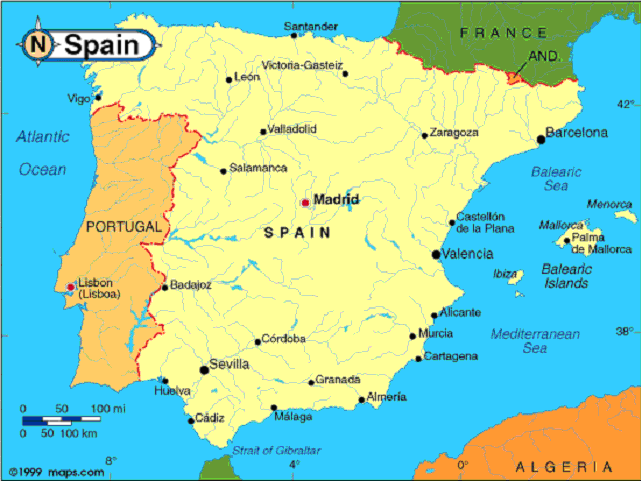
Political Map of Spain

La Casa de Bernarda Alba (1936)
|
|
The
Zeitgeist of Modernism
Lorca, The
House of Bernarda Alba, Act
I (outline)
Homework:
|
|
|
|
|
|
|
|
5
|
10
|
Day 2
|
Tues.
|
|
|
|

Murillo,
The Immaculate Conception, ca. 1678
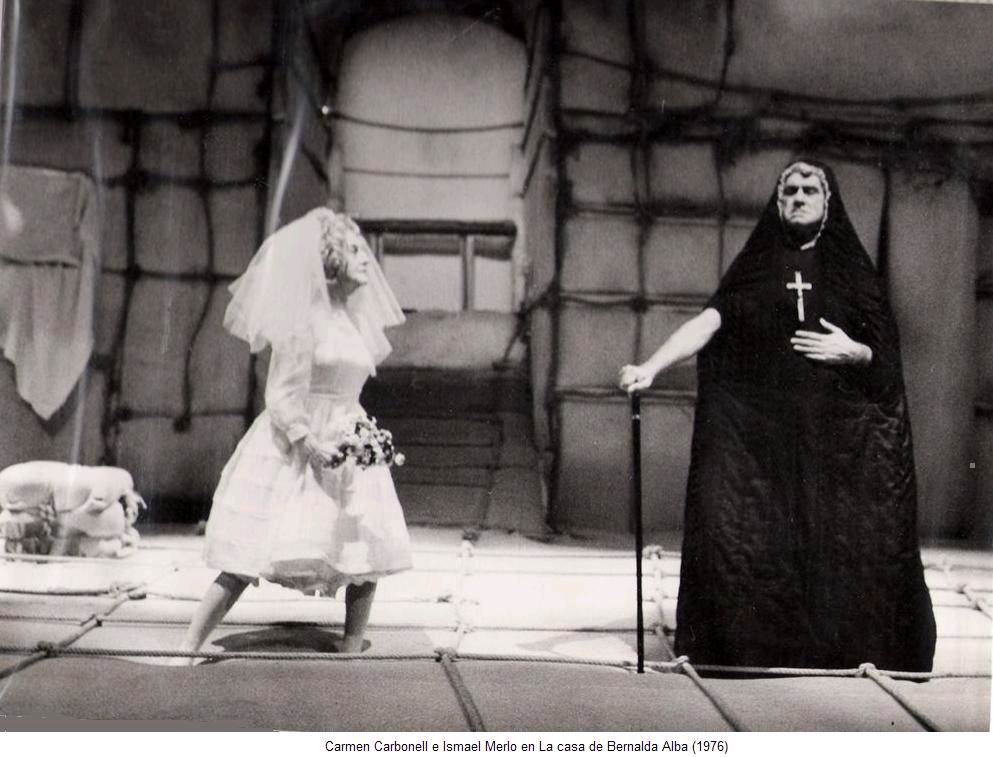


|
|
The
Crisis of Liberalism
Lorca,
The House of Bernarda Alba,
(outline)
Europe
Between the Wars
The
Spanish Civil War Chronology (ppt)
Bernarda Alba Lecture Notes
Act One:
The day of the funeral of Don Antonio Maria Benevides. Pepe el Romano
has been visiting the house each night since the master’s death, yet
secretly, he has been visiting two windows: both Angustias’ (the
heiress) and Adela’s (the beauty).
Act Two: Action: La
Poncia encourages the girls to dream, but she seeks to prevent Adela
from acting on her fantasies. Bernarda believes she has everything
under control until La Poncia forces her to see the truth: Adela is
capable of anything.
Act
Three: Night. The bells of the rosary are heard, interrupted
by the hooves of the stallion, smashing apart its stable so that it can
get to the mares in heat.
Homework:
Paragraph for Final Exam
on Lorca, The House of Bernarda Alba
|
|
|
|
|
|
|
|
5
|
11
|
Day 3
|
Wed.
|
|
|
|
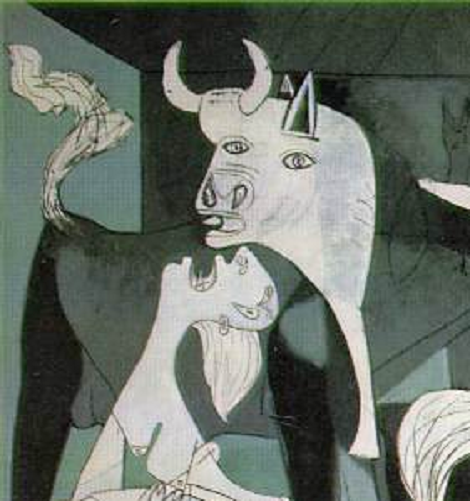
Picasso, Guernica detail (1938)

Dali, Soft
Construction with Boiled Beans (Premonition of Civil War) (1936)

Boccioni, Unique Forms of Continuity in Space (1913)
|
|
Final Exam
2011:
The Cosmic Salon:
The Lessons of the Modern Era
What have we learned from
the terrible ordeals of the twentieth century? What would the following
thinkers say about the prospects of liberalism surviving the 21st
Century? How will liberals like you and me discover a path that can
lead to a better, if not a perfect world?
You must use the writer whose name is in
red. Choose at least five more writers,
thinkers or characters from any of the groups to include in your
conversation.
Invite your salon members
to a Bunker Block at the Auschwitz prison camp in the winter of 1944,
just after Primo Levi had arrived on the transport from Italy.
Lorca,
The House of Bernarda Alba,
(outline)
Europe
Between the Wars
Bernarda Alba Lecture Notes
Act One: The day of the
funeral of Don Antonio Maria Benevides. Pepe el Romano has been
visiting the house each night since the master’s death, yet secretly,
he has been visiting two windows: both Angustias’ (the heiress) and
Adela’s (the beauty).
Act Two: Action: La
Poncia encourages the girls to dream, but she seeks to prevent Adela
from acting on her fantasies. Bernarda believes she has everything
under control until La Poncia forces her to see the truth: Adela is
capable of anything.
Act
Three: Night. The bells of the rosary are heard, interrupted
by the hooves of the stallion, smashing apart its stable so that it can
get to the mares in heat.
Homework:
|
|
|
|
|
|
|
|
5
|
12
|
4
|
Thurs.
|
|
|
|


Soviet soldiers fighting in the ruins of Stalingrad, 1942
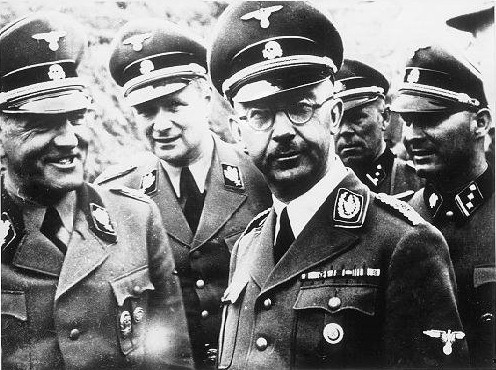
Heinrich Himmler (1900-1945)

Reinhard Heydrich (1904-1942)

Adolph
Eichmann (1906-1962)

Kenneth
Branaugh and Stanley Tucci
in Conspiracy (2001)
|
|
The War in the East:
Operation Barbarossa
The Origins of the Nazi Final Solution:
· Dogmatists
vs. Skeptics
· reductionist
(intentionalist) vs. extensionalist
(structuralist)
· Mayer's Thesis
· The
Centrality of Barbarossa
Homework:
Yaffa Eliach, "Jew,
Go Back to the Grave"
For further
reading: "The Miscarriage of Barbarossa" Chapter 8 from Arno Mayer's Why
Did the Skies Not Darken (1989)

|
|
|
|
|
|
|
|
5
|
13
|
5
|
Fri.
|
|
|
|

Operation
Barbarossa Sept. 1941

Kiev 1941
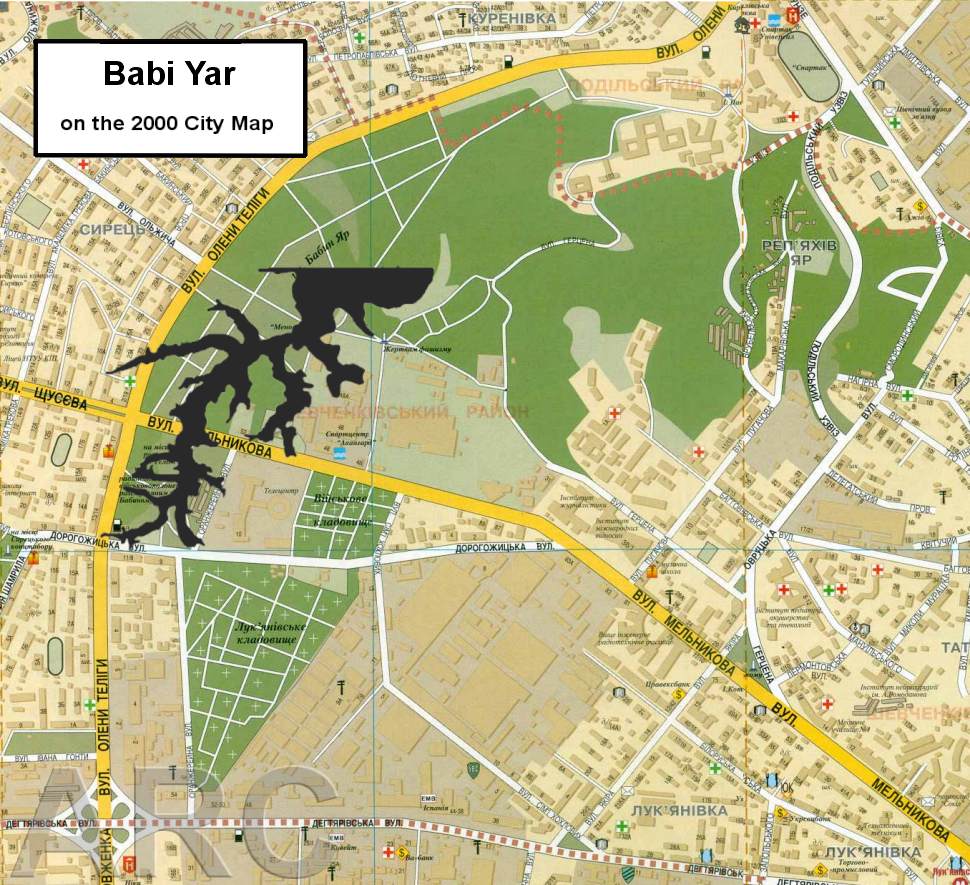

The Ravine at
Babi Yar September 29-30, 1941

Women
Prisoners at the Ravine of Babi Yar
|
|
Final Exam
2011:
The Cosmic Salon:
The Lessons of the Modern Era
Exam Schedule 2011
When
did the Final Solution finally metamorphose from a forced emigration
program into an effort to exterminate all the Jews in Europe?
Babi
Yar:
Homework:
|
|
|
|
|
|
|
|
5
|
16
|
6
|
Mon.
|
|
|
|
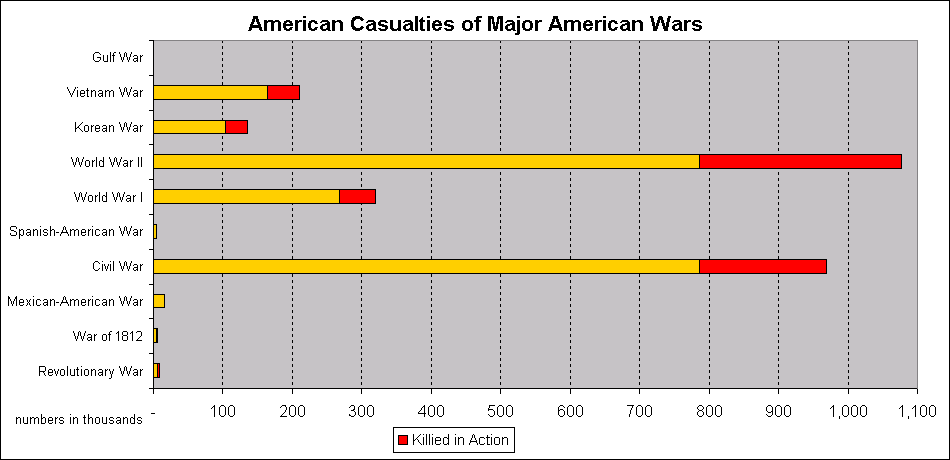
American Casualties of American
Wars
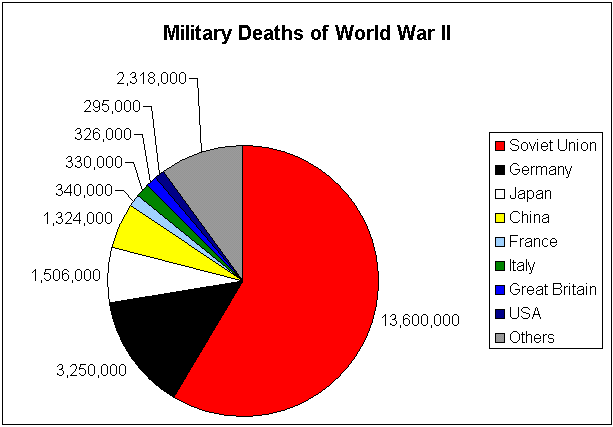
World War Two Military Deaths
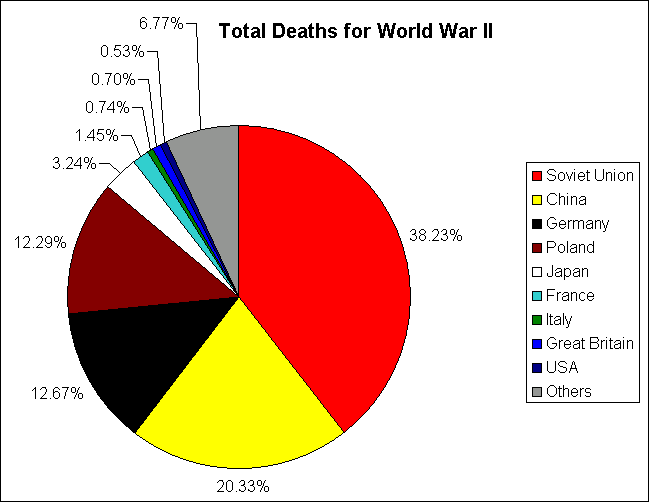
World War Two: Total Deaths

The Main Gate at Auschwitz

Entrance to the Gas Chamber at Auschwitz
|
|
Fussell, "The
Real War, 1939-1945", The Atlantic, vol.
264 No.2, (August, 1989) (Quiz)
Final Exam
2011:
The Cosmic Salon:
The Lessons of the Modern Era
Exam Schedule 2011
The Cosmic Salon:
The Lessons of the Modern Era
What have we learned from
the terrible ordeals of the twentieth century? What would the following
thinkers say about the prospects of liberalism surviving the 21st
Century? How will liberals like you and me discover a path that can
lead to a better, if not a perfect world?
You must use the writer whose name is in
red. Choose
at least five more writers, thinkers or characters from any of the
groups to include in your conversation.
Invite your
salon members to a Bunker Block at the Auschwitz prison camp in the
winter of 1944, just after Primo Levi had arrived on the transport from
Italy.
Homework:
|
|
|
|
|
|
|
|
5
|
17
|
7
|
Tues.
|
|
|
|

Primo Levi (1919-1987)

Ella Liebermann-Shiber (1927-1998)
In the Freight Wagon 1945-1949

David Olère, Selection and
Blocks 2 to 5, Birkenau
(1945)
|
|
Final Exam
2011:
The Cosmic Salon:
The Lessons of the Modern Era
Exam Schedule 2011
The
Cosmic Salon:
The Lessons of the Modern Era
Discussion:
The Nazi Psychological Assault:
Survival
in Auschwitz, pp.9-38: Preface; “The Journey”;
“On the Bottom”
(Quiz)
In English the original
title of Levi’s memoir: “Se questo e un uomo…” is “If This Is a Man…”
Can you finish the sentence for him?
Levi took his own life
years later in 1987. He survived Auschwitz physically, but in the end
it can be argued that the experience robbed him of his life.
Throughout the fourth
quarter we have been thinking about how the Greek Ideal was challenged
by the twin forces of industrial revolution and colonialism.
Ultimately, the social pressures of industrial change led to outbursts
of savagery among the most advanced nations on earth.
How can the curious title
of Levi’s memoir and his ultimate rejection of life be linked to our
understanding of the ultimate fate of liberalism? (Discussion 1)
Homework:
|
|
|
|
|
|
|
|
5
|
18
|
8
|
Wed.
|
|
|
|

David Olère, Selection and
Blocks
2 to 5, Birkenau
(1945)

David Olère Arrival 1945

David Olère New Prisoners 1945
|
|
Final Exam
2011:
The Cosmic Salon:
The Lessons of the Modern Era
Exam Schedule 2011
The Cosmic Salon:
The Lessons of the Modern Era
Survival in
Auschwitz, pp.38-77 "Initiation",
“Ka-Be”,
“Our Nights”,
“The Work”,
“A Good Day”
(Quiz)
(Discussion 2)
Homework:
|
|
|
|
|
|
|
|
5
|
19
|
9
|
Thurs.
|
|
|
|
|

Ella Liebermann-Shiber In the Barracks (1945-1949)

Ella Liebermann-Shiber (1927-1998)
Eating 1945-1949
|
|
Final Exam
2011:
The Cosmic Salon:
The Lessons of the Modern Era
Exam Schedule 2011
The Cosmic Salon:
The Lessons of the Modern Era
Class
Discussion: The Economics of Auschwitz: pp.77-116
“This Side of
Good and Evil”, “The
Drowned and the Saved”, “Chemical
Examination”, “The Canto of
Ulysses” (Quiz)
(Discussion 3)
Homework:
|
|
|
|
|
|
|
|
5
|
20
|
10
|
Fri.
|
|
|
|

Ella Liebermann-Shiber (1927-1998) Soup Distribution
1945-1949

David Olère They Tried to Escape (1946)
|
|
Final Exam
2011:
The Cosmic Salon:
The Lessons of the Modern Era
Exam Schedule 2011
Survival
in Auschwitz, pp. 116- 145
“The Events of
the Summer”, “October 1944”,
“Kraus”,
“Die drei Leute vom Labor” (Quiz) (Discussion 4)
Can humanity survive the
reduction of life to material necessity? Does morality exist in the
natural state of man?
|
Steinlauf (41)
Null Achtzen (42)
Alberto (57) (139)
The Greeks (71)
Schepshel (92)
Alfred L. (93)
Henri (94)
Elias (95)
Alex and Dr. Pannitz (101)
|
Jean the Pikolo
(112)
Lorenzo (119)
Ziegler (129)
Kuhn (129)
Kraus (132)
Primo (134)
The Lab Girls (141)
The Last One
(149-50)
Charles (167)
|
Homework:
|
|
|
|
|
|
|
5
|
23
|
1
|
Mon.
|
|
|
|

Ella Liebermann-Shiber, Death March (1945-1949)
|
|
Final Exam
2011:
The Cosmic Salon:
The Lessons of the Modern Era
Exam Schedule 2011
The
Cosmic Salon:
The Lessons of the Modern Era
Survival in Auschwitz, pp.145-175
“The Last One”,
“The Story of
Ten Days” (Quiz)
Can humanity survive the
reduction of life to material necessity? Does morality exist in the
natural state of man?
|
Steinlauf (41)
Null Achtzen (42)
Alberto (57) (139)
The Greeks (71)
Schepshel (92)
Alfred L. (93)
Henri (94)
Elias (95)
Alex and Dr. Pannitz (101)
|
Jean the
Pikolo (112)
Lorenzo (119)
Ziegler (129)
Kuhn (129)
Kraus (132)
Primo (134)
The Lab Girls (141)
The Last One
(149-50)
Charles (167)
|
|
|
Write
thesis statement on Survival in Auschwitz.
Homework:
|
|
|
|
|
|
|
5
|
24
|
2
|
Tues.
|
|
|
|

Ella Liebermann-Shiber, Death March (1945-1949)

Ella Liebermann-Shiber, Revolt in Birkenau (1945-1949)
|
|
Final Exam
2011:
The Cosmic Salon:
The Lessons of the Modern Era
Exam Schedule 2011
The
Cosmic Salon:
The Lessons of the Modern Era
Exam Review: Grammar and Usage
Exam Review: Vocabulary
Survival in Auschwitz, pp.145-175
“The Last One”,
“The Story of
Ten Days” (Quiz)
Can humanity survive the
reduction of life to material necessity? Does morality exist in the
natural state of man?
|
Steinlauf (41)
Null Achtzen (42)
Alberto (57) (139)
The Greeks (71)
Schepshel (92)
Alfred L. (93)
Henri (94)
Elias (95)
Alex and Dr. Pannitz (101)
|
Jean the
Pikolo (112)
Lorenzo (119)
Ziegler (129)
Kuhn (129)
Kraus (132)
Primo (134)
The Lab Girls (141)
The Last One
(149-50)
Charles (167)
|
|
|
Isaiah
Berlin on Pluralism
and on Freedom
from, My Intellectual Path (1975)
|
|
|
|
|
|
|
5
|
25
|
3
|
Wed.
|
Reading Day |
|
|
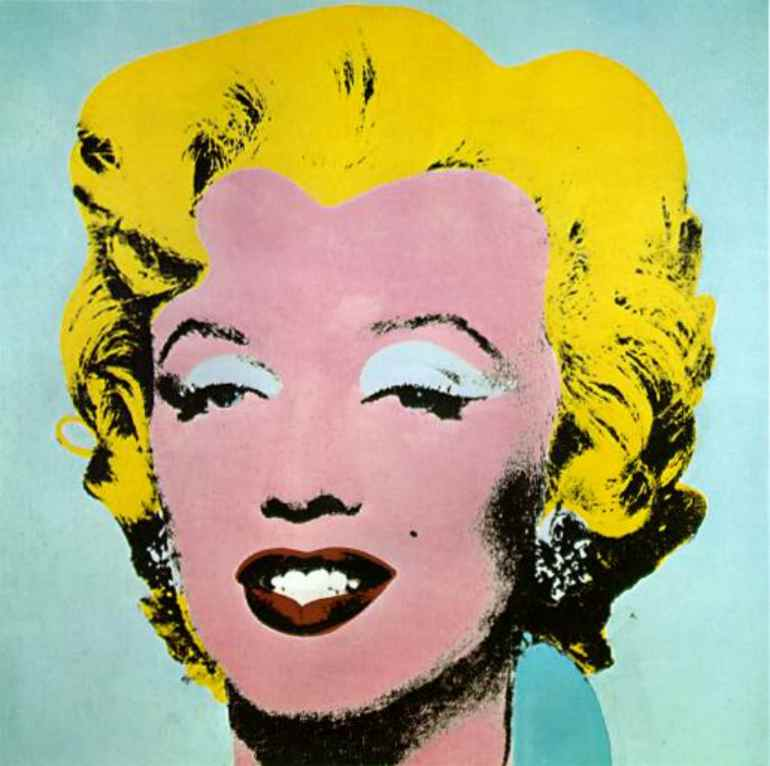
ANDY WARHOL, Marilyn
Diptych, 1962.
Oil, acrylic, and silk screen enamel on canvas.
Tate Gallery, London.
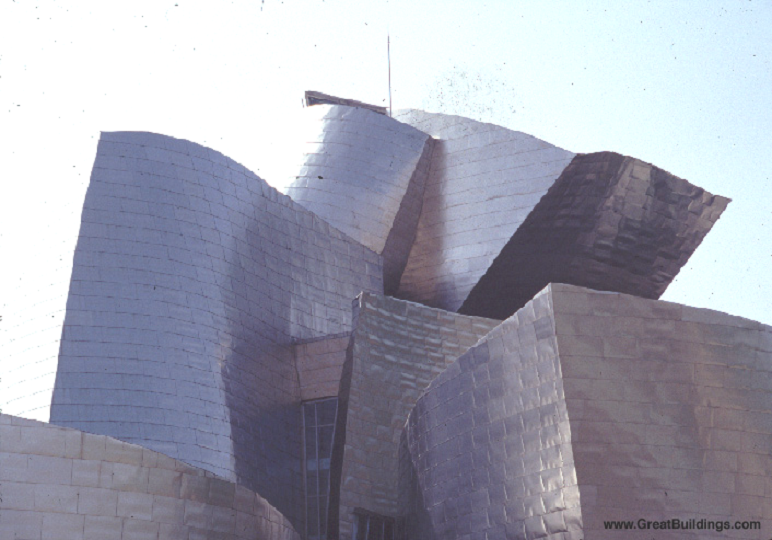
FRANK GEHRY, Guggenheim
Museum,
Bilbao, Spain, 1997.
|
|
Exam Review: Grammar and
Usage
Exam Review: Vocabulary
The
Cosmic Salon:
The Lessons of the Modern Era
Final Exam
2011:
The Cosmic Salon:
The Lessons of the Modern Era
Exam Schedule 2011
Post
Modernist Art
|
|
|
|
|
|
|
|
|
|
|
|
5
|
26
|
4
|
Thurs.
|
Exams
|
|
|
|
|
|
|
5
|
27
|
5
|
Fri.
|
Exams
|
|
|
|
|
|
|
5
|
30
|
0
|
Mon.
|
Memorial
Day
|
|
|
|
|
|
|
5
|
31
|
6
|
Tues..
|
Exams
|
|
|
|
|
|
|
|
6
|
1
|
7
|
Wed.
|
Exams
|
|
|
|
|
|
|
|
6
|
2
|
8
|
Thurs.
|
Exam
Make-Up Day
|
|
|
|
|
|
|
|
6
|
4
|
|
Sat.
|
Baccalaureate
|
|
|
|
|
|
|
6
|
5
|
|
Sun.
|
Founder's Day
|
|



















































































































































